ARCHIVE 2017-18 |
INTRODUCTION |
| Imaging from the worst place on Earth? Possibly!
Welcome to my image blog from Lancashire, UK. Living in Lancashire does make imaging a challenge. Our incessant damp cloudy weather is legendary and coupled with light pollution probably as bright as can be found anywhere (I am 15 miles NW of the centre of Manchester) makes for testing times! Add to that flight path one with constant aeroplanes, which is why it has been suggested as possibly the worst place on Earth for imaging. But there is some good news. With modern light pollution filters we can still produce excellent results - at least when the clouds clear - but of course it's not easy. It would be so much simpler to log onto a robotic rent-a-scope and let them take the image for us. But if you are up for the challenge and the achievement of taking your own images, with your own equipment, in your own back garden, then I hope the following offers some encouragement. Yes it's difficult but we can do it. I shoot the luminance and the colour simultaneously - there are not enough clear spells to allow the luxury of shooting separately. Shooting LRGB with one telescope would take years! So two telescopes and two cameras was the obvious solution . Also necessary is having a dome slot wide enough for both to have a clear line of sight. The luminance is usually taken with the RCOS + Apogee Alta and the colour with the Takahashi + Canon DSLR. Despite their disparate focal lengths this works reasonably well as my current Canon has 4.3 micron pixels (plate scale 2 arcsecs/pixel) and the Apogee 18 micron ones when binned 2x2 (plate scale 1.3 arcsecs/pixel). I find binning essential to maximise signal and improve the signal-to-noise ratio. The images are all taken from my back garden and appear in order of me processing them - we have plenty of cloudy nights for that. I use a combination of IRIS and Maxim for processing with final tweaks in Photoshop. To get rid of the light pollution takes much trial and error. IRIS scores here with several options but processing often comprises many nights work - certainly always longer than the actual taking. The exception are images taken with an h-alpha filter which is a superb light pollution filter. It also permits imaging with strong Moonlight present - isn't it funny how it always seems to be clear at full Moon!
|
|
|
15th December 2018M77 and Supernova SN 2018ivc |
47 million years ago in a galaxy far far away a star exploded. Its light has just reached Lancashire! It is close to the galaxy's centre so not easy to spot and the weather only allowed a few hazy shots last night. Inset is of my previous image of 10 years ago. Update: it would appear that the supernova is no where near as bright as it should be (15th mag?) and this is put down to probable obscuration -it is after all very close the the centre of the galaxy. Image Details
|
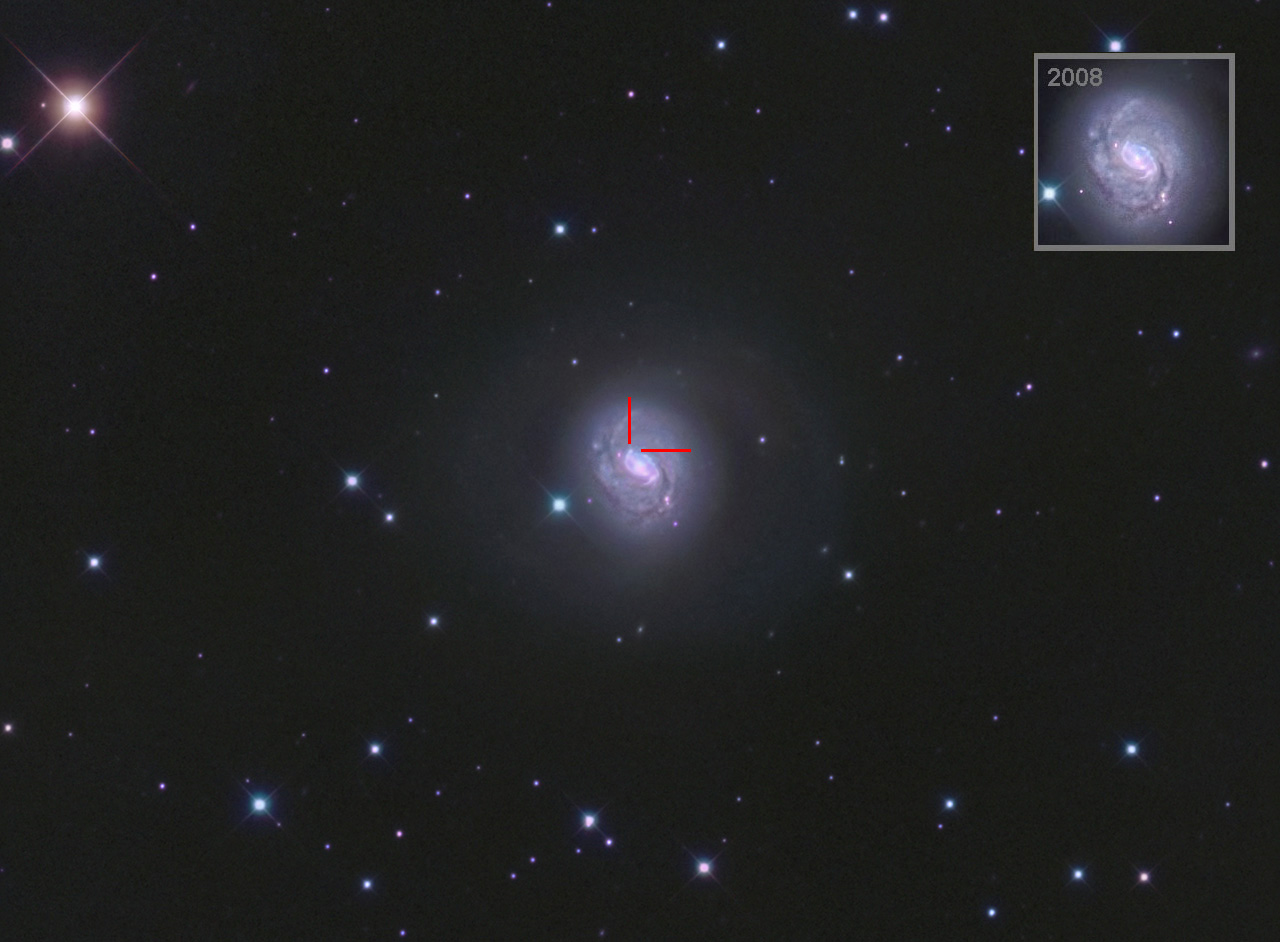 |
M77 and Supernova 2018
|
|
2nd December 2018Globular Cluster M15 |
Whilst shooting the planetary nebula ngc7094 I couldn't resist the temptation to also shoot the nearby globular cluster M15. Messier 15 is one of the brightest globular clusters in the northern sky and is home to around 100,000 stars. It is one of the most densely packed globulars in the Milky Way galaxy and is classed as 'core collapsed'. Whether it has a black hole at its centre is subject to much speculation in professional research papers. Even images taken with the Hubble Space Telescope were unable to resolve its dense core and solve the problem. Image Details
|
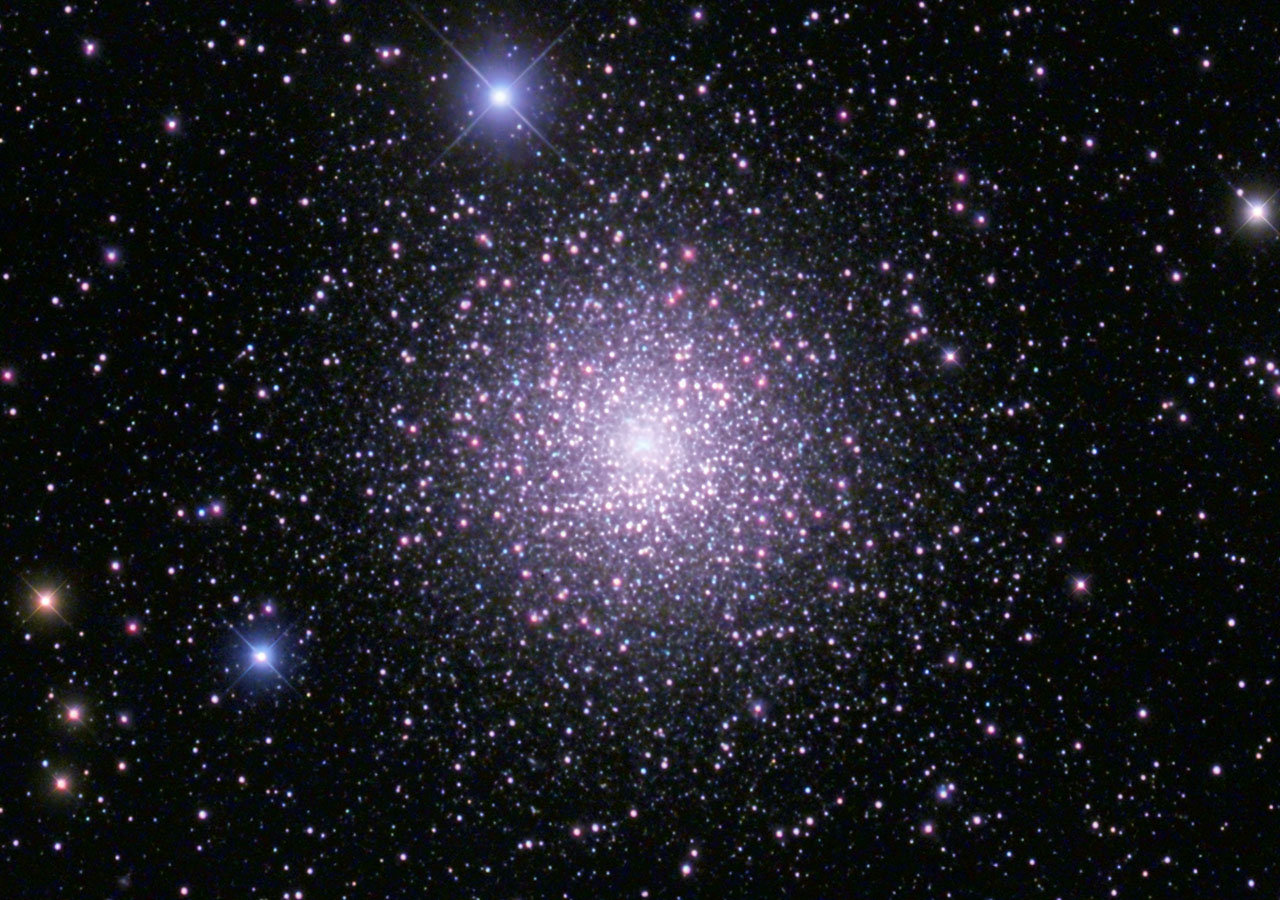 |
M15 |
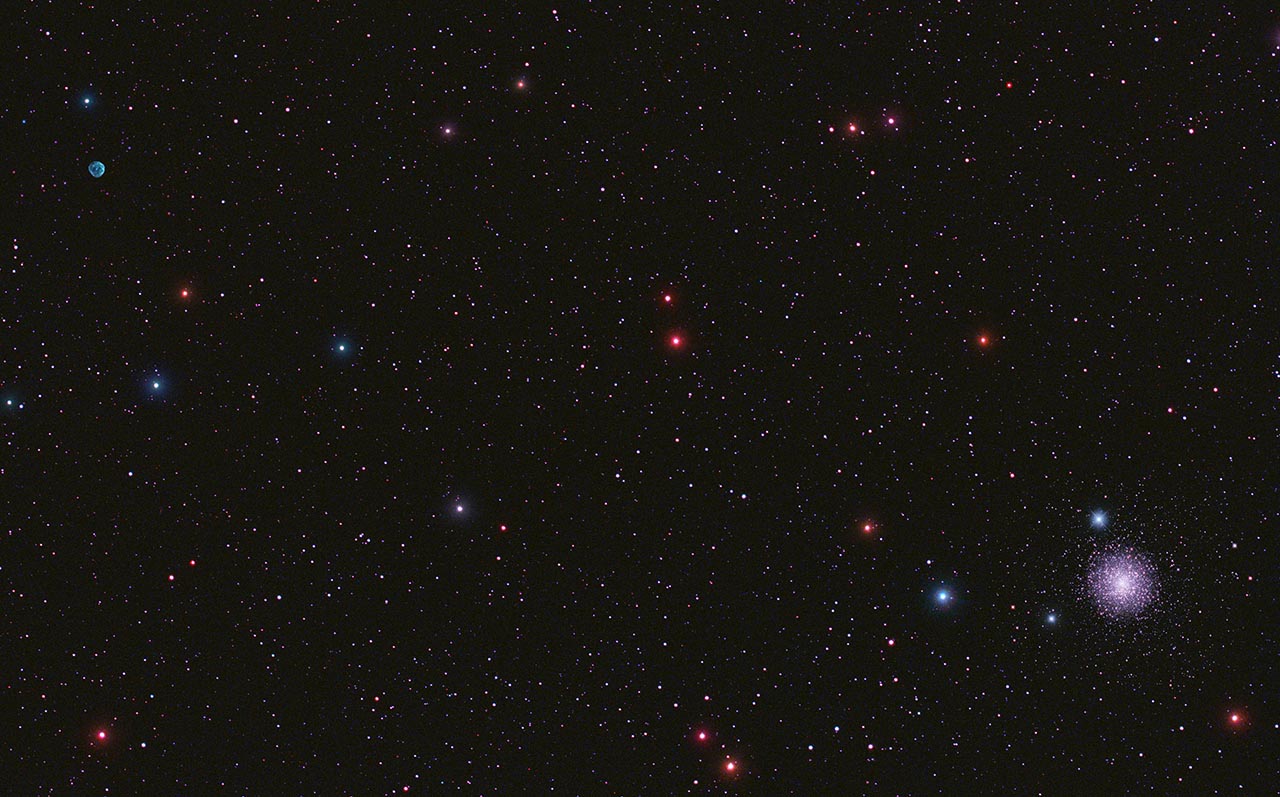 |
NGC7094 & M15
|
|
21st November 2018Planetary Nebula NGC 7094 |
There is growing evidence that planetary nebula are much more likely to form in binary systems. This would also explain how they can produce such a wide variety of morphologies. However, even so some shapes are so "messy" - as is the case with NGC 7094 - that perhaps triple or even multiple stars systems must be involved. In a recent paper, Bear & Soker, place NGC 7094 in the category "Maybe shaped by a triple stellar progenitor" - see reference. They were not certain in this case as they though intereaction with the interstellar medium could have preduced the asymmetry. They concluded that according to their assumptions about 13%–21% of PNe have been shaped by triple stellar systems. They concluded "Although in some evolutionary scenarios not all three stars survive the evolution, we encourage the search for a triple stellar systems at the center of some PNe". Ref: Planetary Nebulae that Cannot Be Explained by Binary Systems, Ealeal Bear and Noam Soker, 2017. With virtually no Ha signal present I shot this nebula using an OIII filter only - the Takahashi providing the broadband colour. Image Details
|
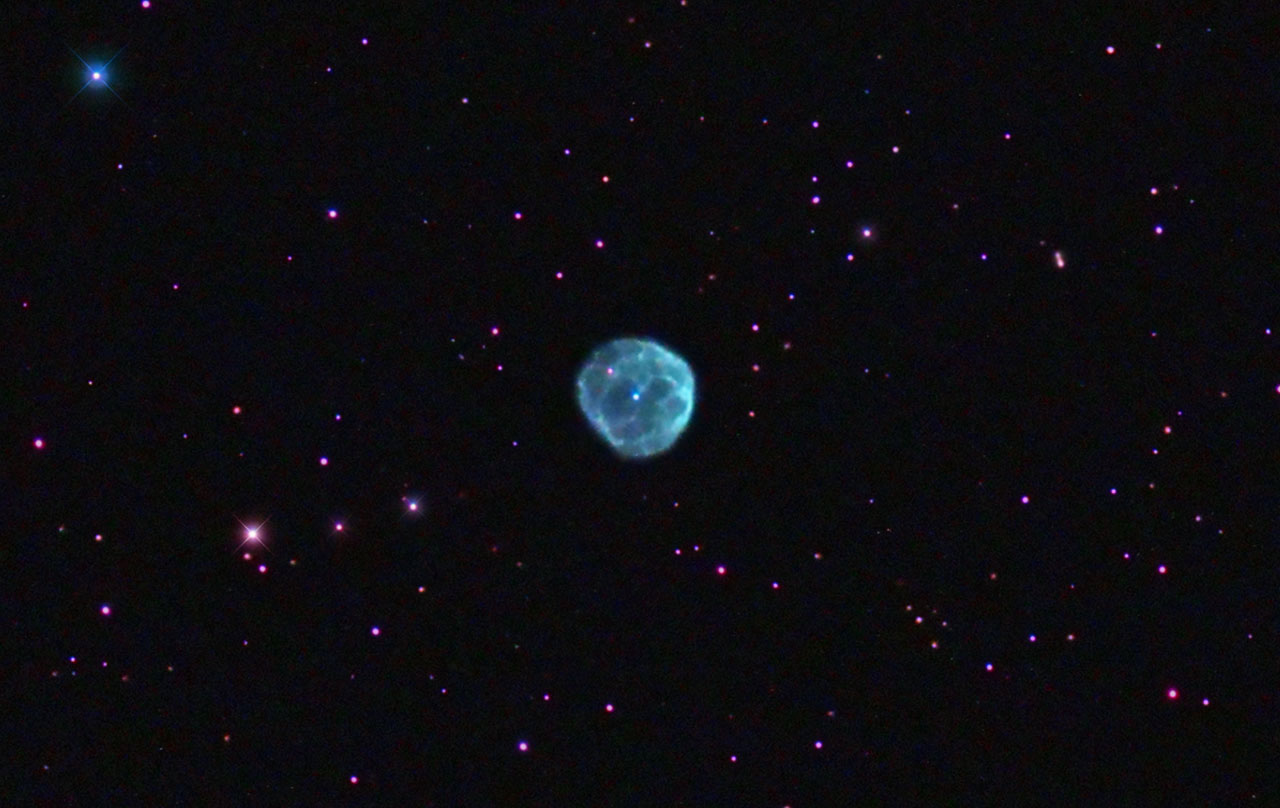 |
Planetary Nebula NGC 7094
|
|
8th November 2018Pegasus Dwarf Irregular Galaxy, DDO216 |
Known at PegDIG to professional astronomers, this dwarf galaxy is described as a "low-luminosity transitional-type" between dwarf spherical and dwarf irregular ie dSph/dIrr. It is part of the local group and is a distant satellite of M31. It was discovered in the 1950s on Palomar Schmidt plate by A.G. Wilson and is now known to be around 3 million light years away. It is somewhat unusual in that star formation has almost ceased despite still being gas rich - it has a 1:1 gas to stellar ratio. There is some evidence that it is rotating. Recently (see reference) Hubble Space Telescope images have confirmed the presence of a substantial globular cluster (DDO216-A1) near the centre of the galaxy. It is relatively large with a mass of around 100,000 solar masses ie this makes it bigger than 90% of the Milky Way globulars. The PegDIG galaxy is the lowest luminosity local group galaxy to host such a large globular cluster. The Hubble images were able to identify RR variable stars (at around 25th to 26th magnitude!) enabling its distance to be confirmed and Its age be be estimated to be around 12.3 billion years. The images right show the location of the globular. The top image is Cole et al's wider field negative image using the Hubble. The rectangle is the position of the Hubble colour image at the bottom. Cole et al. did not have north at the top so their images have been rotated accordingly. The middle image is a blow-up of my image. Originally I thought this must be the core of the galaxy and it was after digging through the research papers did I realise it was a globular cluster. The bottom image is a colour Hubble image again rotated to have north at the top and does begin to show that it really is a large globular cluster. The tiny edge-on galaxy is way in the background and its resdshift (0.0689) indicates a distance of around 900 million light years. PegDig is located just below the bottom of the Square of Pegasus. Ref: Cole at al. "DDO216-A1: A Central Globular Cluster in a Low-luminosity Transitional-type Galaxy", 2017
Image Details
|
 |
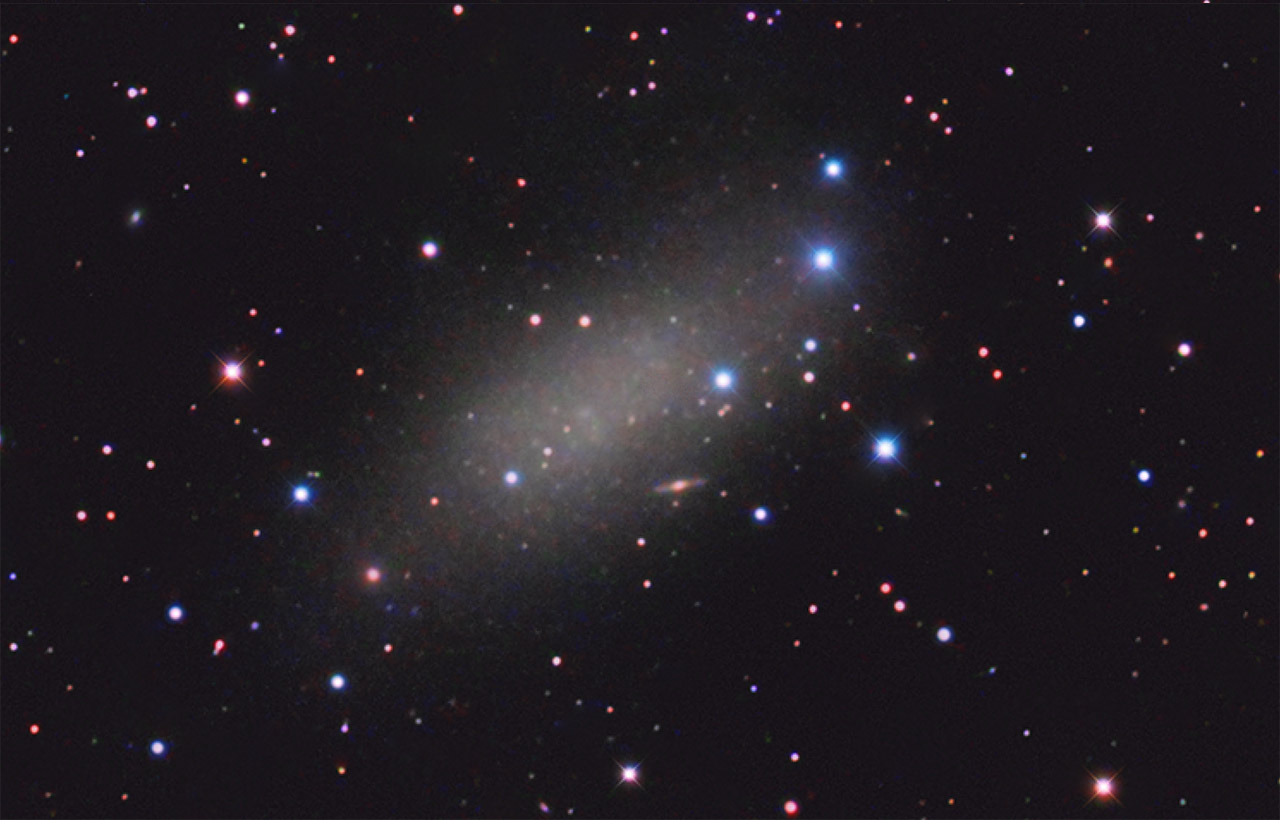 |
Pegasus Dwarf Galaxy
|
|
17th October 2018Open Cluster, Messier 29 |
Located in Cygnus, this young open cluster does look to a certain extent like a smaller Pleiades. Strangely not many published images of this object - guess there are more spectacular objects around it. Until very recently the distance and age of this cluster was very poorly known with widely varying estimates over the years. This changed in 2014 with the publication by Straizys et al., The Enigma of the Open Cluster M29 (NGC 6913) Resolved. The determined its distance to be 5,000 light years and its age 5 million years. The problem was complicated by the fact that not all stars here are actual cluster members. Of the 7 brightest stars, the blue one is a background blue giant and the "handle" star (top left) a foreground object. To reduce the blooming (bleeding) from the bright stars I decreased my normal exposures from 20 mins down to 10 mins. I also shot half before a meridian flip and half afterwards so the blooms went in opposite directions. Image Details
|
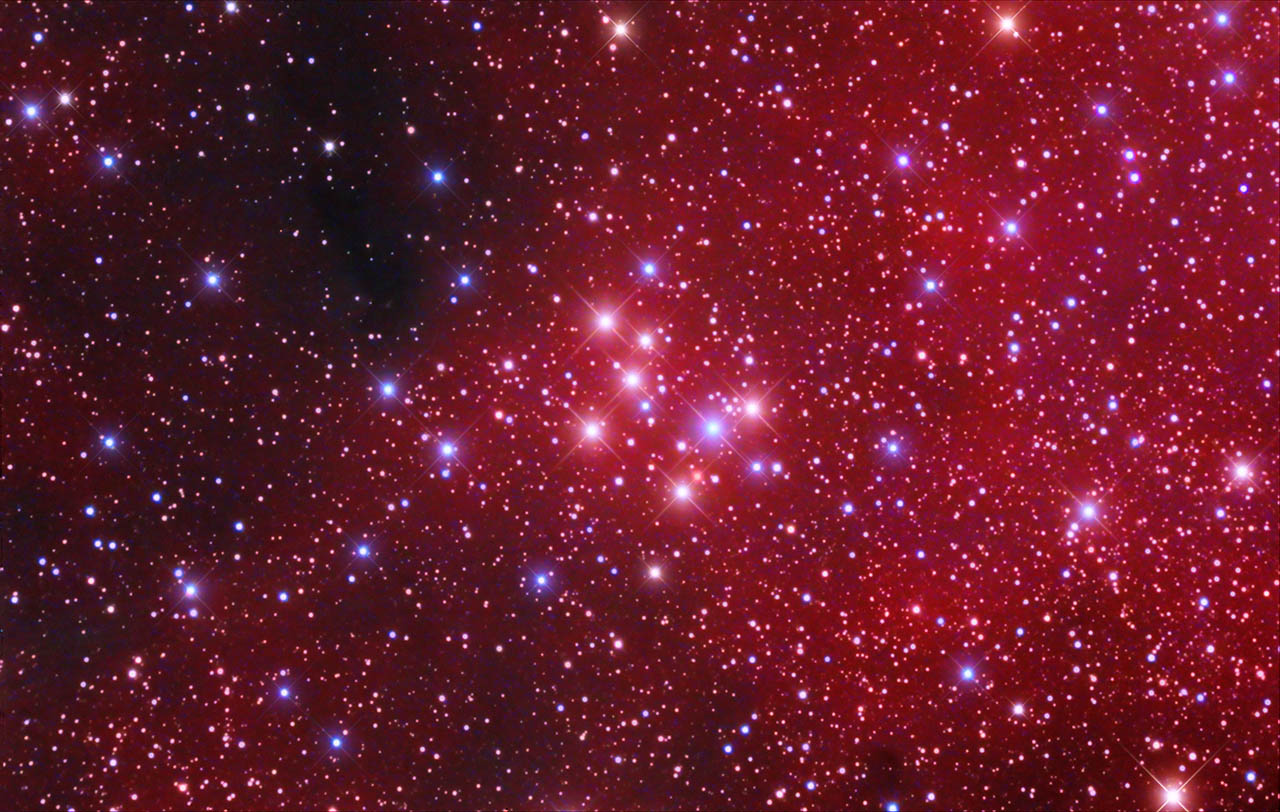 |
Open Cluster M29
|
|
10th October 2018Escaping the Void, AlfaZoa J1952+1428 |
Our local group of galaxies and most of our neighbours form part of a remarkably flat structure known as the Local Sheet. This is actually a wall of the Local Void. The latter extends for 240 million light years with very little in it - certainly no big galaxies and probably containing a smattering of dark matter and occasional dwarf galaxies. The Local Void is largely hidden from view being located behind the Milky Way. It pokes out either side just a bit into Aquila and Sagittarius. That explains why the name of this galaxy has Zoa in its title. ZOA of course stands for Zone of Avoidance - that part of the sky where galaxies appear to be absent because the Milky Way blocks our view. Radio telescopes on the other hand are able to detect galaxies behind our galaxy. AlfaZoa is one of only 2 well established galaxies in the Local Void and was found as part of a ZOA radio survey by the Arecibo Radio Telescope. It was detected by is HI emission which actually extends much further out than its optical size. Theory has it that voids expand and anything inside them will be rushing out to escape. This theory was recently proved to be correct (see reference). AlfaZoa is racing out of the void at 370 km/sec. It is a dwarf galaxy like Magellanic Clouds but around 100 times further away at 27 mly. This distance makes it very much towards our side of the void. It is can be found in Aquila. The Hubble image was acquired over 4 orbits and was able to resolve its stars and enable the calculation of its distance. Ref: Rizzi, Tully et al, Draining The Void, 2016.
Image Details
|
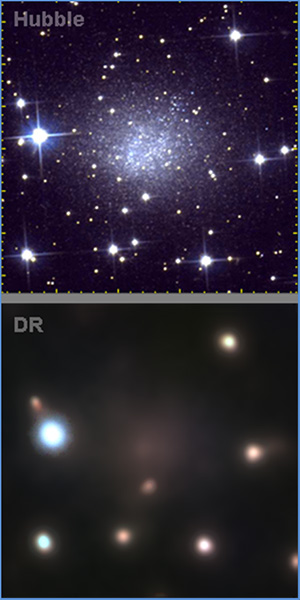 |
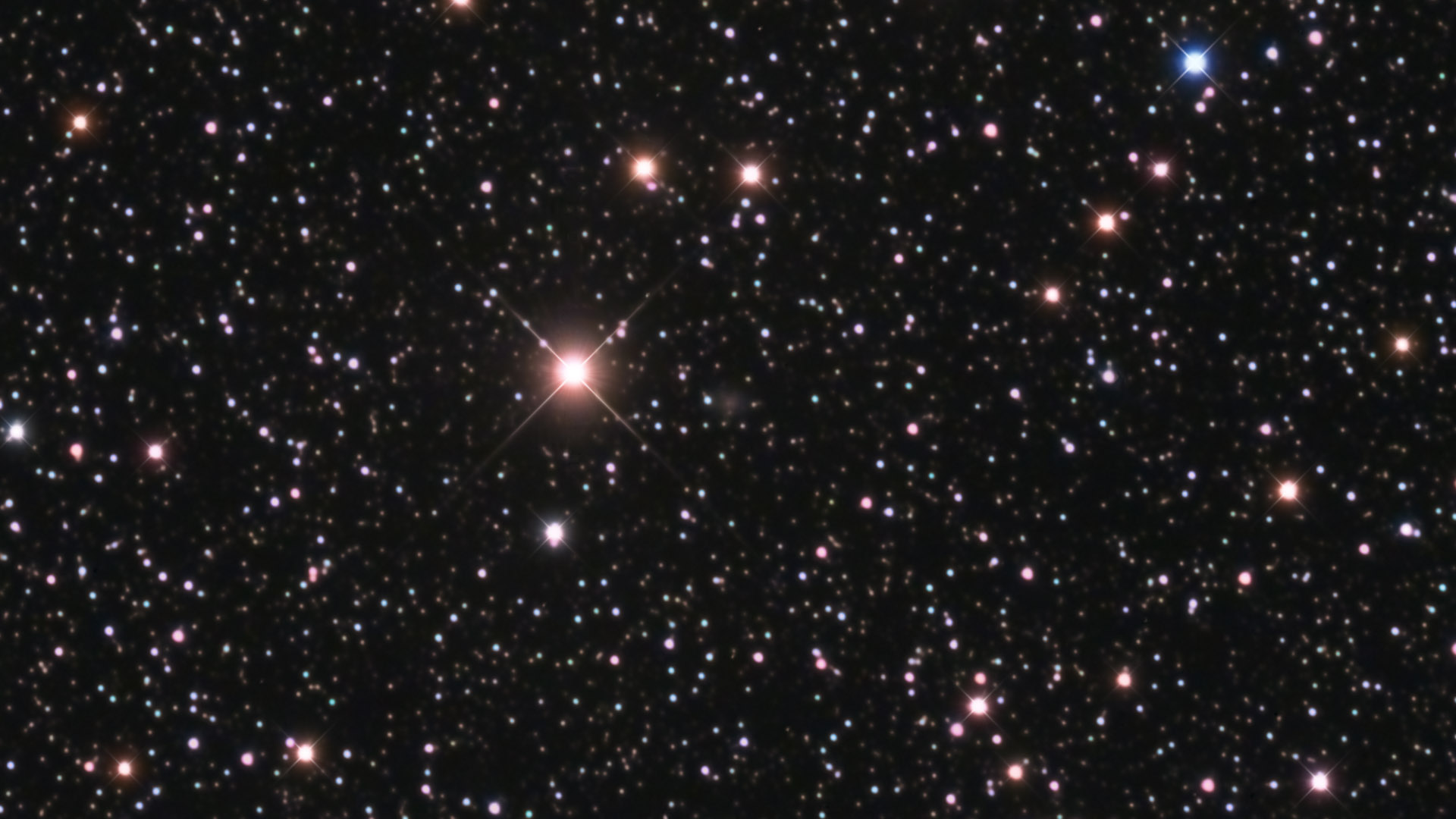 |
Alfazoa J1952+1428
|
|
3rd October 2018Blazar BL Lacertae |
The Observatory re-opened after an 18 month interruption. Boy was it difficult re-learning everything. What made it worse was the observatory computer had failed and all the systems had to re-loaded with of course all the correct parameters re-set. First target was therefore something easy! It took many years for astronomers to work out what this object was - it has a featureless spectrum with no absorption or emission lines. Over the years ideas ranged from a peculiar variable star or even a planetary nebula (Arp) in our own galaxy. We now know it is a Blazar - a quasar where the jet from its central black hole is pointing straight at us. Key to this was determining its redshift but with that featureless spectrum is was very tricky. Only when the light from its centre was blocked was an elliptical galaxy with a red shift of 0.07 revealed. Its distance is around 900 million light years. It does vary in brightness over very short timescales but in my (raw) images it looks around magnitude 14.5. Located in western Lacerta so we are looking very close to the plane of the Milky Way - hence the large number of foreground stars and faint nebulosity more evident in the wide field view. I didn't get BL Lac very central - lack of practice! Image Details
|
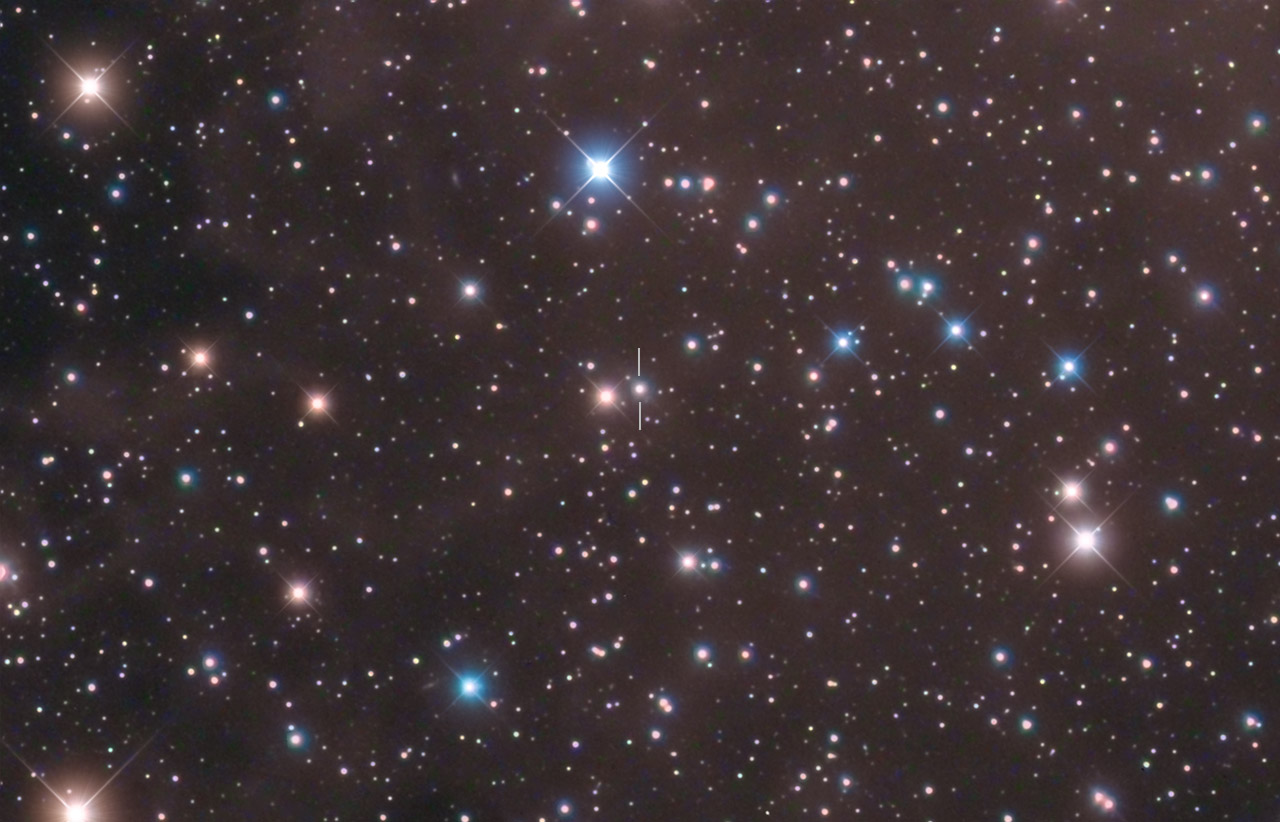 BL Lac - detail image
|
BL Lac - full frame image
|
12th June 2018Jupiter - altitude 20 degrees |
|
What could be better on a warm summer evening than to image Jupiter whilst sat in a deck chair! Very low this year from Lancashire so the ADC (Atmospheric Dispersion Corrector) had to utilised and set to a spacing of 31mm. The webcam is a colour Microsoft webcam which gives a good image size with a focal length of 4 metres. The Celestron C8 is getting on for 25 years old now but it is perfect for the solar system. It requires no heavy battery to carry out - it uses an internal 9v PP9 battery. I have an electric focuser fitted which makes planetary focusing a lot easier - or less hard. Polar alignment is always guessed and adjusted by kicking one the tripod legs. Fairly quick and requires no complicated app. Images stacked using Registax 6 and sharpened using Iris wavelets. Image Details
|
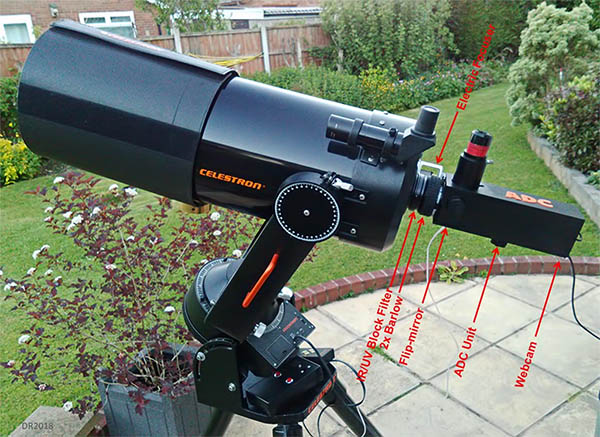 |
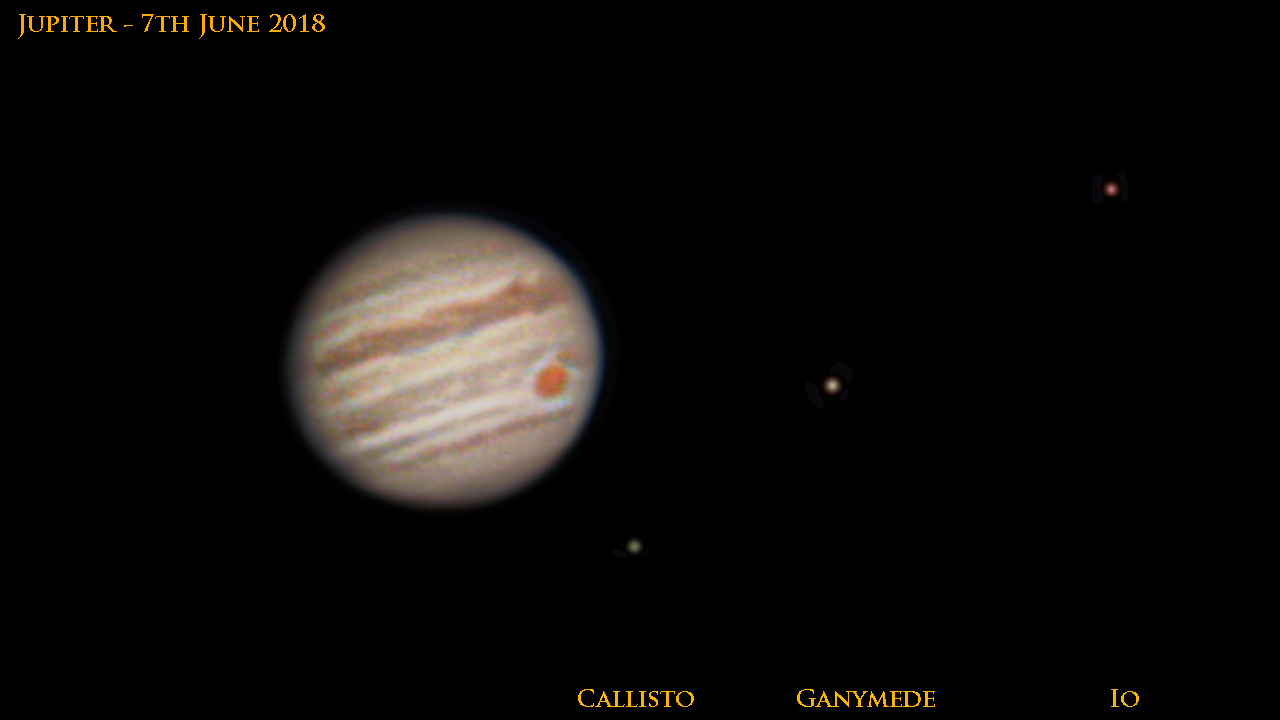 |
| Jupiter 7th June 2018
|
|
24th October 2017Copeland's Septet (VV282, HCG57) |
Discovered by Ralph Copeland in 1874 using the 6 foot "Leviathan of Parsonstown" telescope at Birr Castle, Ireland. He was assistant to Lord Rosse and rose eventually to be Astronomer Royal for Scotland. It was a fortuitous discovery as he was actually looking for another "nebula" but had been given the wrong RA coordinates. He could see 7 nebulae (galaxies) hence septet but there are at least 8 probably 9 associated together - the galaxy marked with "?" has a matching redshift. He catalogued them in the wrong location and the original NGC had them as "non-existent". Fortunately this was subsequently corrected and Copeland given credit.
The distance to the group, based on their redshift and Ned Wright's calculator, is around 430 million light years. Image Details
|
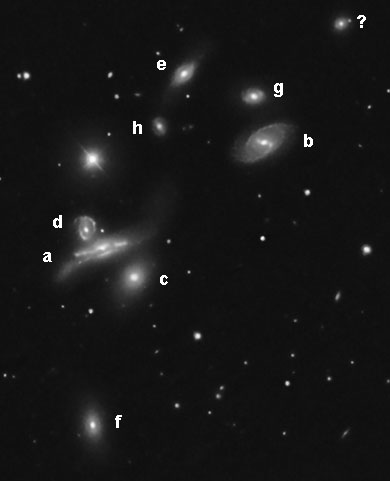 Hickson 57 - Key to members |
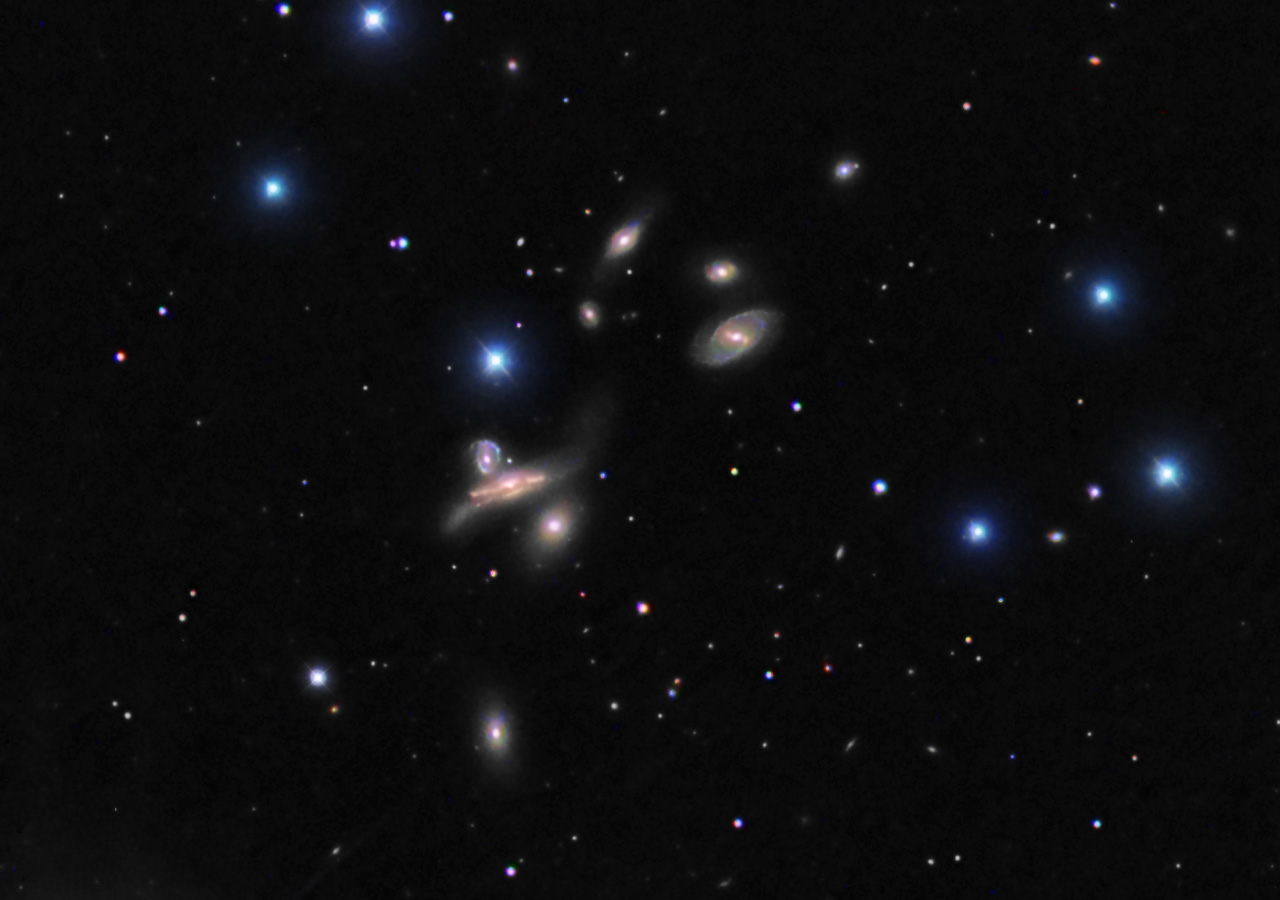 Copeland's Septet - full resolution
|
Copeland's Septet - full frame image
|
|
23rd July 2017Hickson 55 (VV172) |
Discovered by the Russian astronomer Vorontsov-Veljaminov on POSS plates and he catalogued the group as VV 172. Burbidge took an interest in the group and the term galaxy chain was coined. The chain became famous however, in the debate over whether redshifts could be relied upon as distance indicators as the faintest member, second from the top (north) has a much greater redshift than the rest of the group. Arp included it in his catalogue as 329 and Hickson in his as 55. The redshift debate has been long settled but an interesting research paper in 1995 "The nature of discordant redshift galaxies in compact groups" by Mendes de Oliveira proposed a novel, for then, solution as to why groups of galaxies often seemed to have a member with an anomalous redshift. The solution proposed was that the mass of the real group acts as a gravitational lens to magnify and brighten any possible background galaxy in the same line of sight. You would therefore produce more apparent discordant redshift members than pure chance would provide. Gravitational lensing is much more accepted now but for 1995 it was quite a novel explanation. Image Details
|
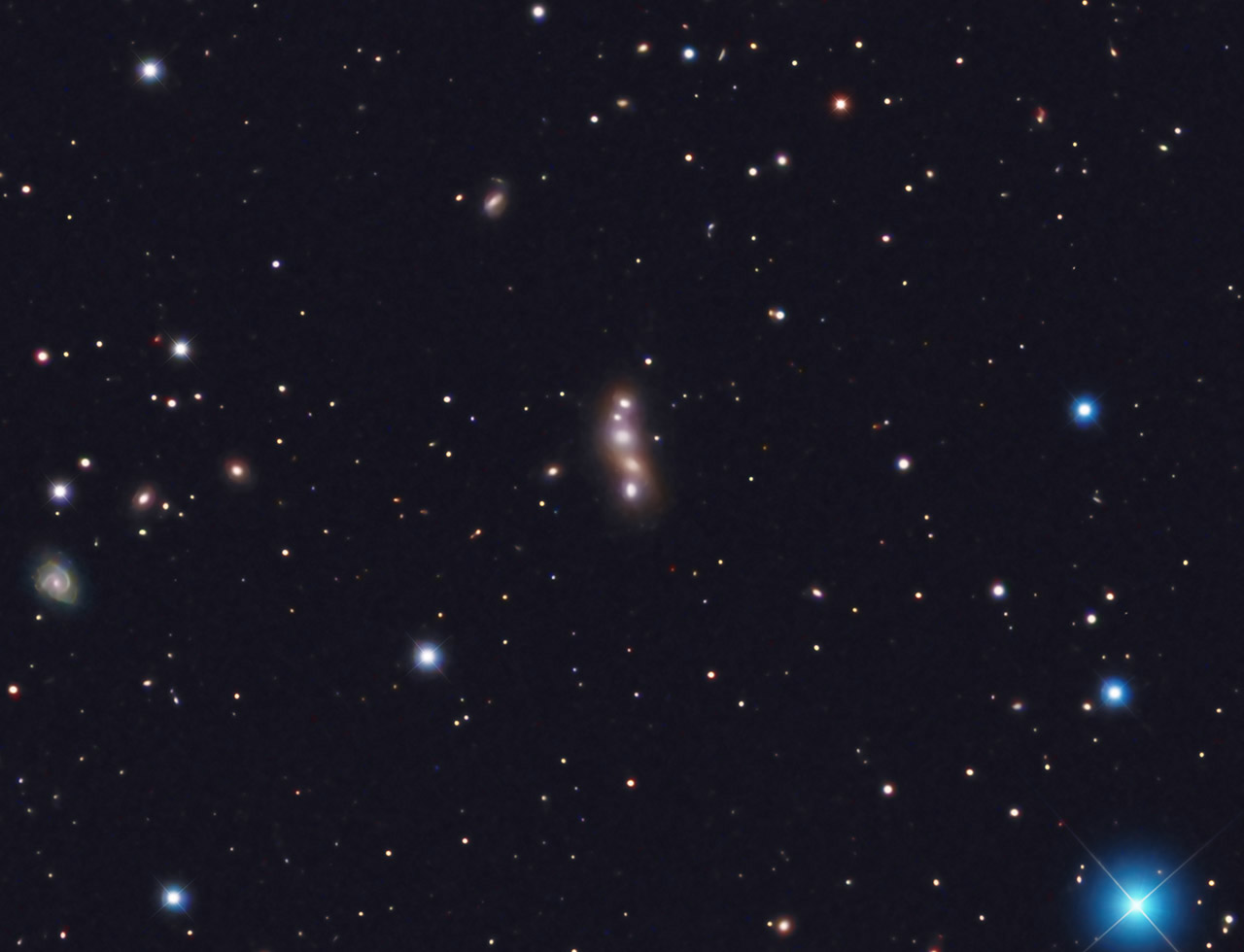 Hickson 55 - detail image
|
Hickson 55 - full frame image
|
|
18th June 2017The Owl and Hickson 50 |
The Owl Nebula, M97, points the way to several obscure objects. Just above it is a faint galaxy and just below it a faint nebula. A little further to the east (left) in the Hickson Galaxy Cluster HCG50. HCG50 is the faintest and has the highest redshift of the 100 Hickson groups. The 5 galaxies form a ring and all have redshifts around z=0.14 although with a high velocity dispersion indicating the presence of dark matter. The redshifts indicate a light travel time of around 1.75 billion years. Although certainly the faintest Hickson group their magnitudes are somewhat disputed. Catalogues place them around mag 18 to 19 but CCD imagers tend to suggest they are around 1 magnitude brighter. Old catalogue values can be blue biased as films were more sensitive to blue wavelengths. The obvious colour of the galaxies in my shot is certainly not blue so it is no surprise their blue mag is faint. CCDs on the other hand are more red sensitive. Either way a big Dobsonian will be needed to see them. As is often the case with the Hickson groups, there are galaxies around around them and with similar brightnesses and colours. However, the two below (south and south-east in the enlarged image) have much lower redshifts but the double galaxy (upper right) does have a matching redshift so is probably associated. Image Details
|
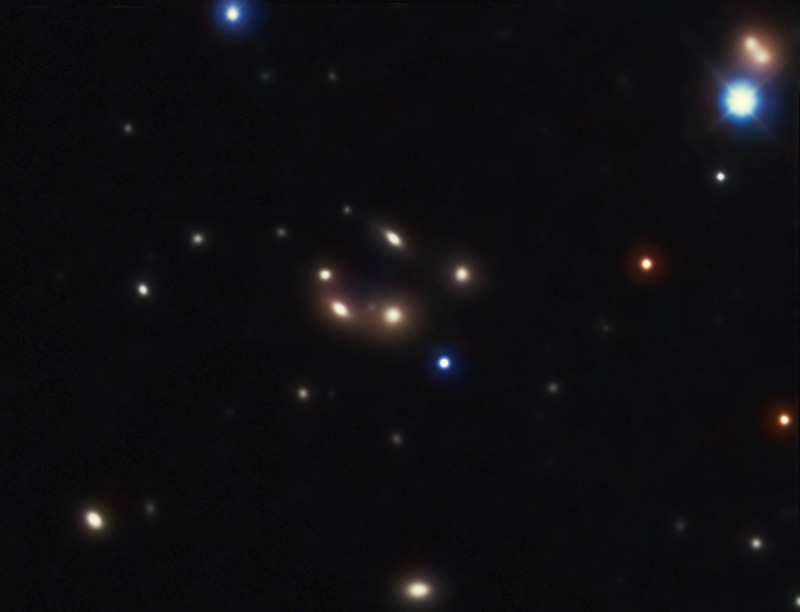 |
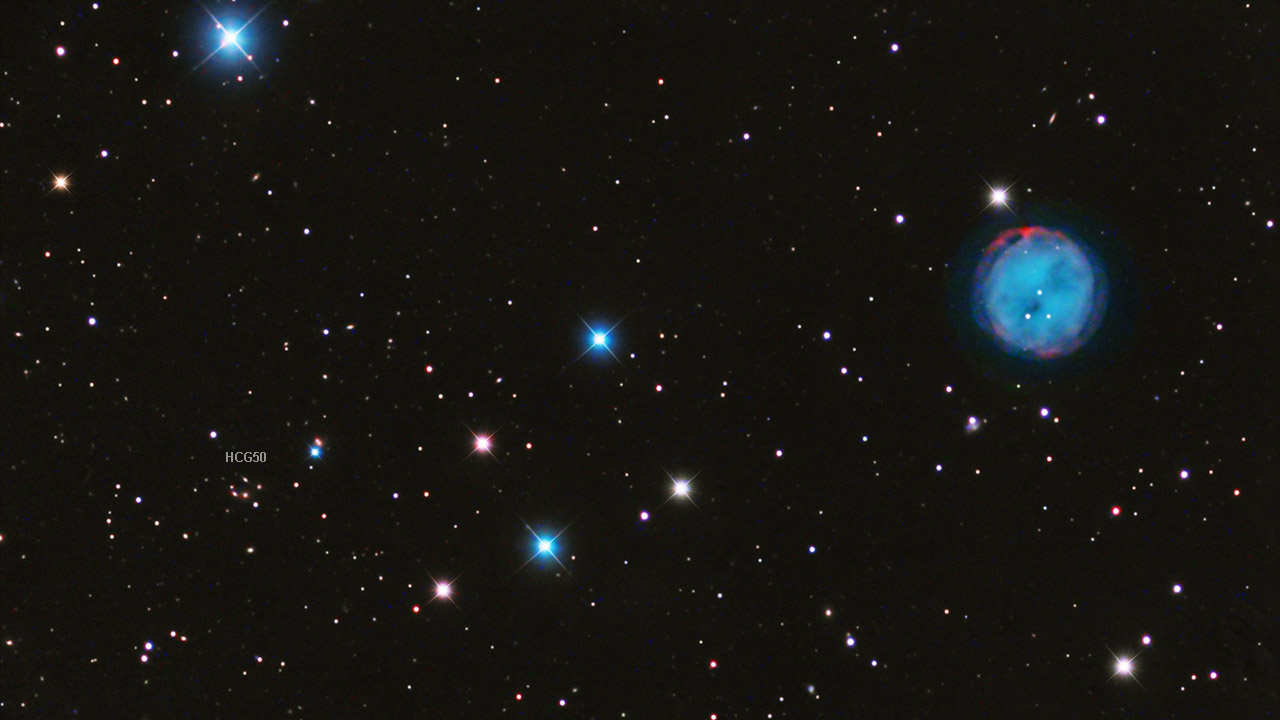 |
The Owl and HCG50
|
|
14th May 2017A Spiral Nebula, Sharpless Sh2-266 |
A very odd nebula and possibly one of the most distant HII regions from the centre of the galaxy. The spiral shape is believed to result from the intense stellar wind from a massive central star known as MW137. Initially thought to be a Herbig-Haro type star it was later found to be a supergiant Be type star by Estban et al. (1998). They concluded it was a "ring nebula", the first such known around a Be supergiant. Visually it looks more like a helix than a ring giving it its spiral appearance. Located in Orion so often over-looked and ignored. There are many more famous objects nearby. Image Details
|
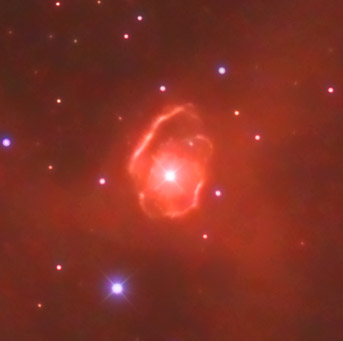 |
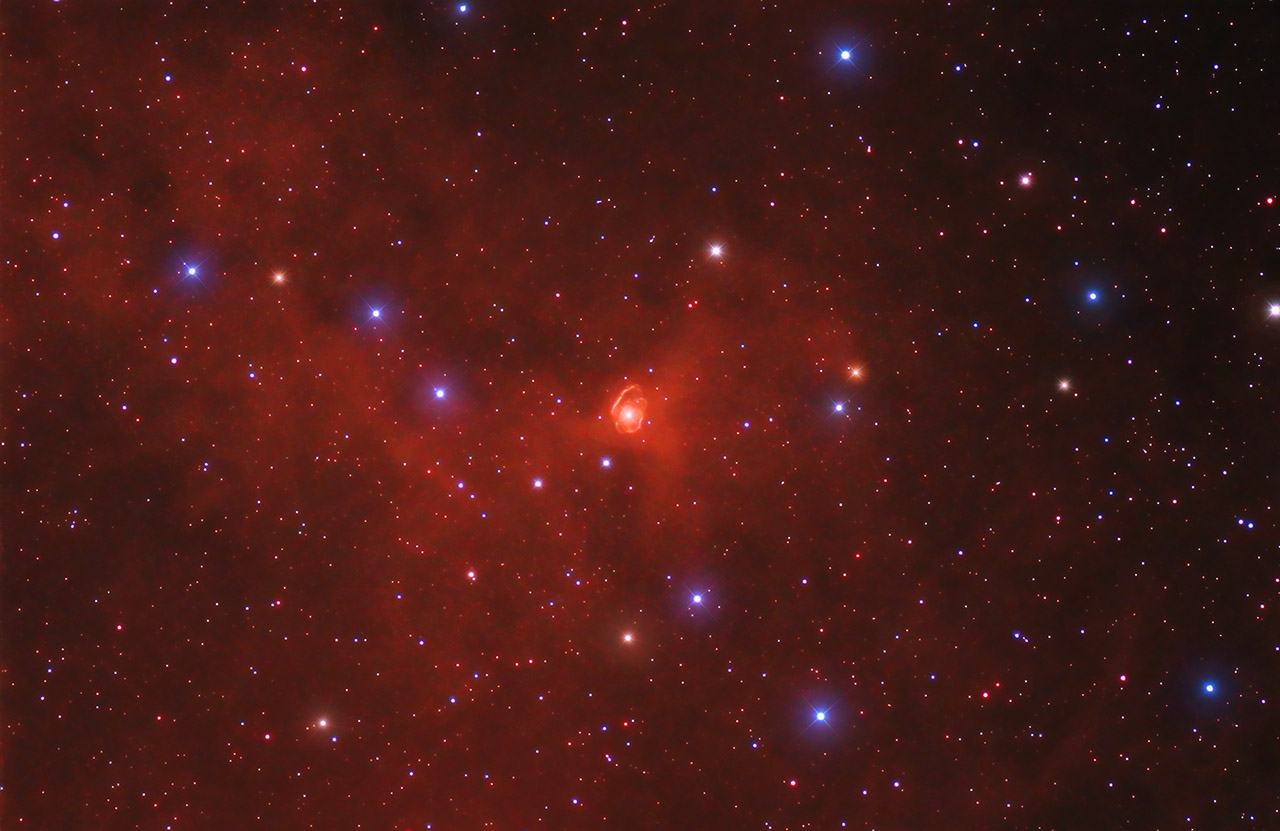 |
Sh2-266
|
|
1st May 2017Sharpless Sh2-235 |
Close up view of Sharpless Sh2-235 taken with the 12 inch RCOS and has much more detail than is evident in the widefield view in my previous image below, which was taken with the 4 inch Tak. Also it becomes very obvious that this group (Sh2-231, 232, 233 & 235) is really all part of one giant nebula. South of Sh2-235 is a tiny nebula previously erroneously classed as a planetary nebula (PN G173.7+02.7). This is actually an emission nebula (confirmed by Kohoutek in 2001) and is now sometimes classified at Sh2-235A. Galaxy Map states "Infrared analysis using the Spitzer space telescope has found 86 young stellar objects within Sh 2-235. Sh 2-235 is ionised by the O9.5 V star BD +35 1201". This is the star just about dead centre of the nebula and image. Image Details
|
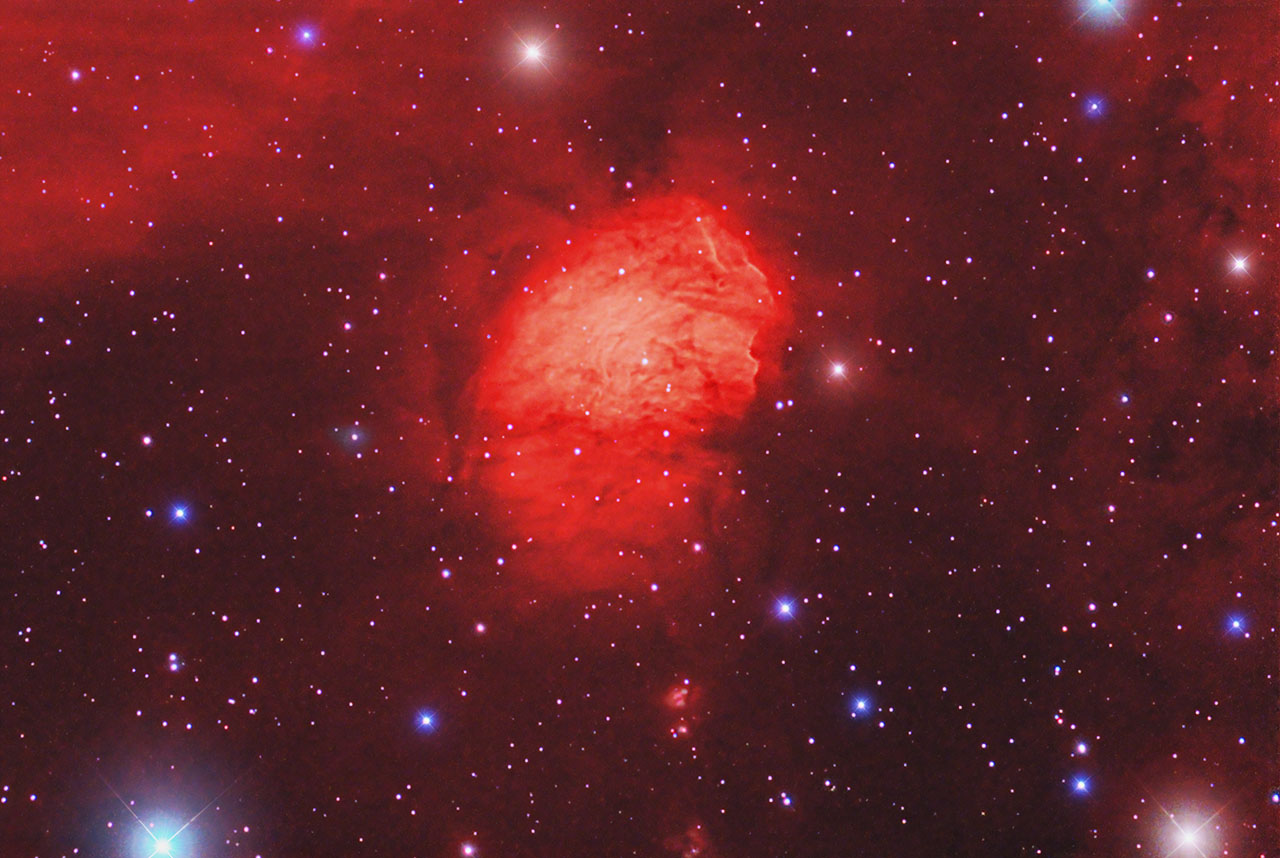 |
Sh2-235
|
|
16th April 2017Sharpless Sh2-231, 232, 233 & 235 |
The Sharpless numbering system went a little awry here and the nebula are from left to right: Sh2-232, -235, -231 and -233 (the smallest). Sh2-235 is the brightest - my image doesn't really represent how faint some of these are - and has below it another tiny nebula previously classed as a planetary nebula (PN G173.7+02.7). This is actually an emission nebula and is now sometimes classified at Sh2-235A. There is a real planetary nebula within Sh2-232 - see right. The nebula in the top right hand corner doesn't seem to have a catalogue number. This grouping is located in Auriga. The following is best information I could find and is from Galaxy Map: Image Details
|
Close-up of planetary nebula in Sh2-232
PN G173.5+03.2 (Pu2) |
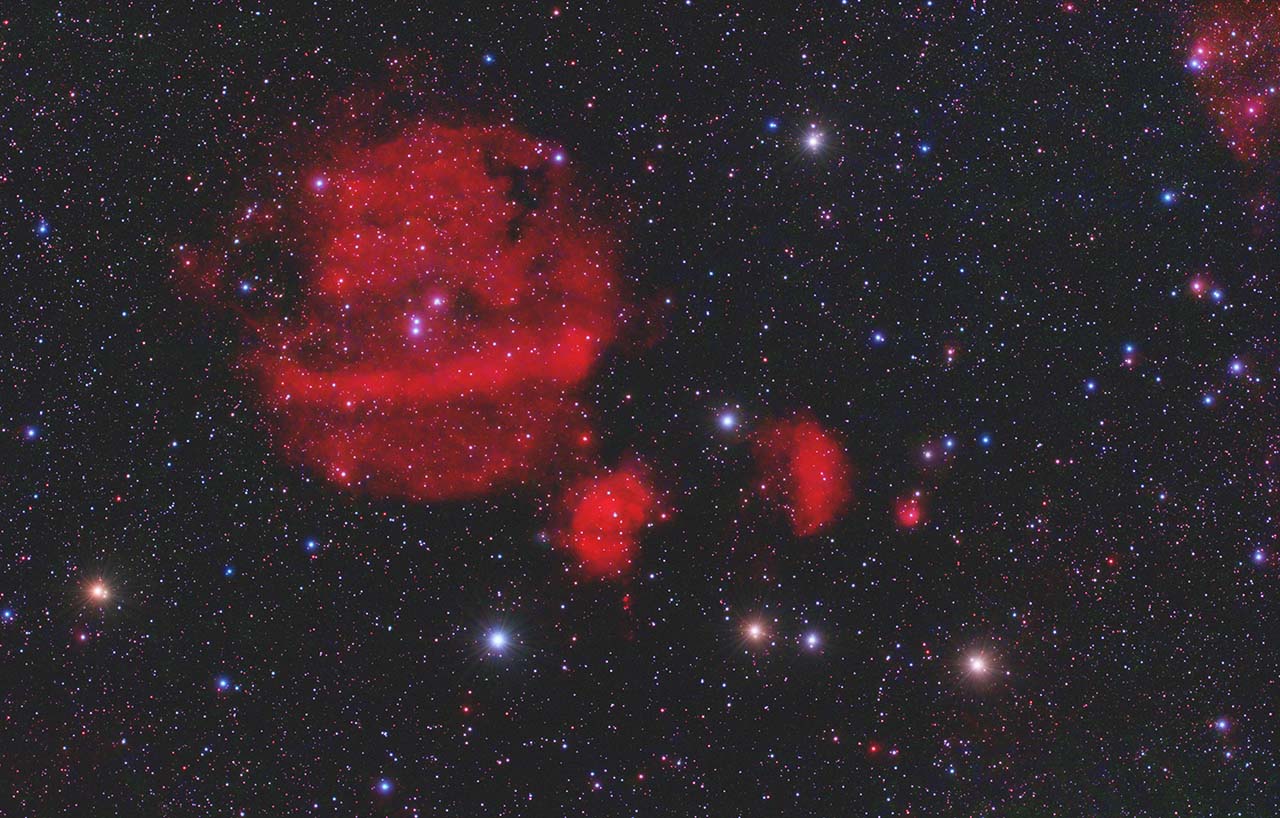 |
Sh2-231, -232, -233, -235
|
|
26th March 2017Trifid of the North, NGC 1579 |
Although sometimes referred to as the Northern Trifid Nebula it really doesn't compare to its southern namesake. It is in fact one of the oddest nebula there is. Often (wrongly) classed as an emission nebula because it is brightest in the red and H-alpha band. Sharpless even included it in his emission nebula catalogue as Sh2-222. It is actually a reflection nebula - ref: Herbig, Andrews & Dahm (AJ2004). If it is a reflection nebula why is it predominently red? That question has made NGC 1579 one of the most studied of nebulae. It was the detection within it of the energising star LkHa101 (see right) that led to the explanation. The nebula is red because of interstellar extinction and the nature of the illuminating source. The theory is that the star LkHa101 is a hot massive star caught very early in its development - less than a million years old. It is surrounded by its own h-alpha emission nebula. It is the light from the latter that illuminates the nebula in h-alpha light. Herbig et al. concluded only when the star's nebula has dispersed will it become visible. Image Details
|
Image centred on the energising star LkHa101 (not visible), which is located just north of the brightest star shown. Both images taken in red band.
|
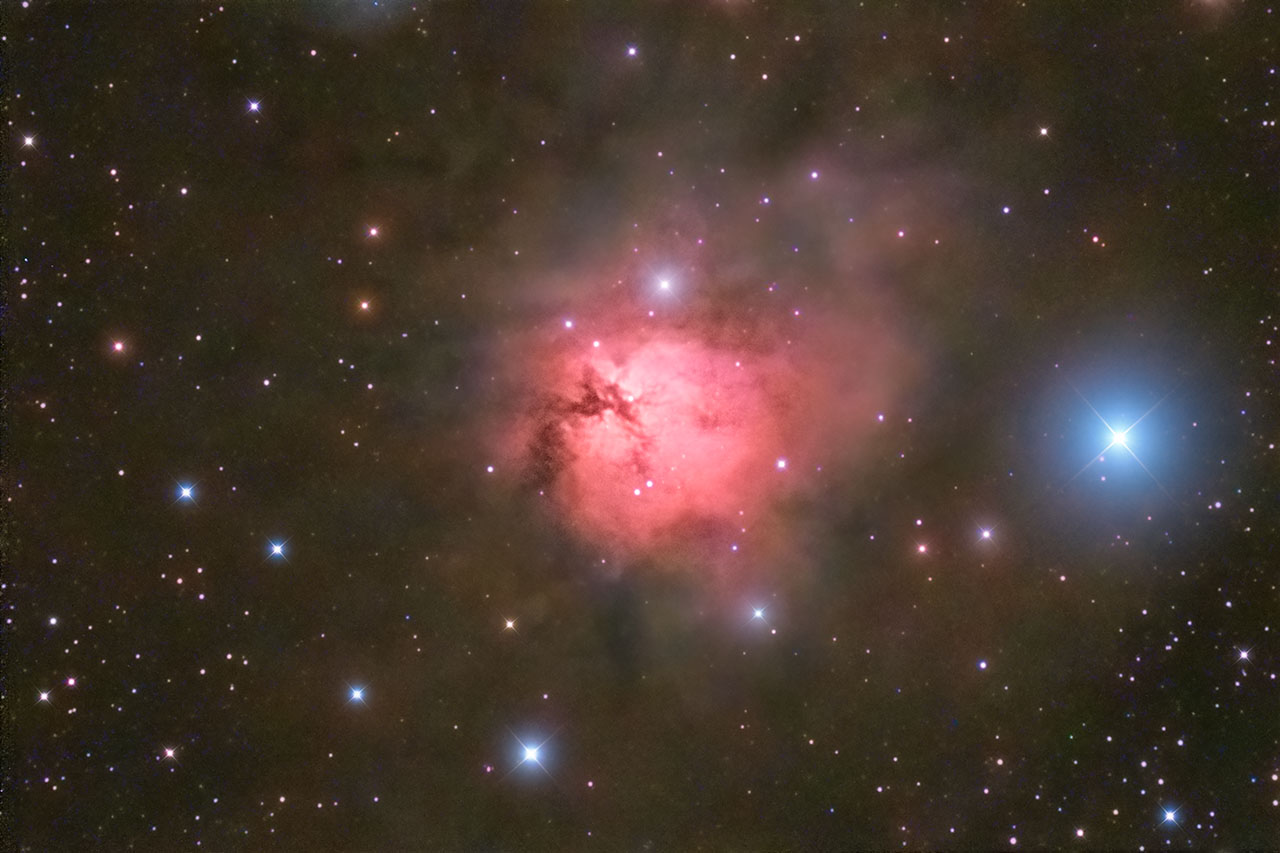 |
NGC 1579
|
|
5th March 2017Planetary Nebula Baade 1 |
Very few images and virtually no data available for this planetary nebula. In addition several catalogues have this object's coordinates wrong. Most catalogue sizes are an underestimate too - they appear to just give the size of the central ring, not the outer halo. Below is Walter Baade's discovery paper published by the Astronomical Society of the Pacific. Surprisingly it is not the faintest of objects despite needing the 100 inch telescope to confirm it. It didn't need super long exposures for me to record it. 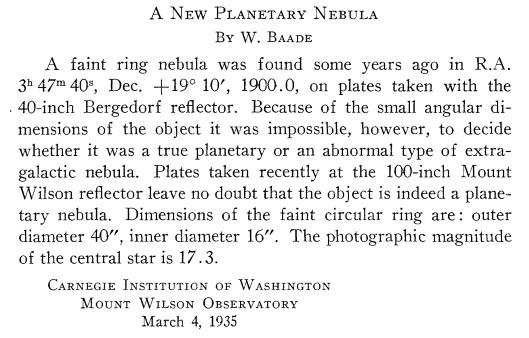 Due east is a very faint galaxy - well faint in my narrowband image which is hardly ideal for galaxies. Image Details
|
Type of object: Planetary nebula Other name: PK171-25.1 RA (J2000.0): 03 53 37 Dec (J2000.0): +19 29 39 Constellation: Taurus Magnitude: 13.9 Size: 50" (estimated) Magnitude of central star: 17.1
|
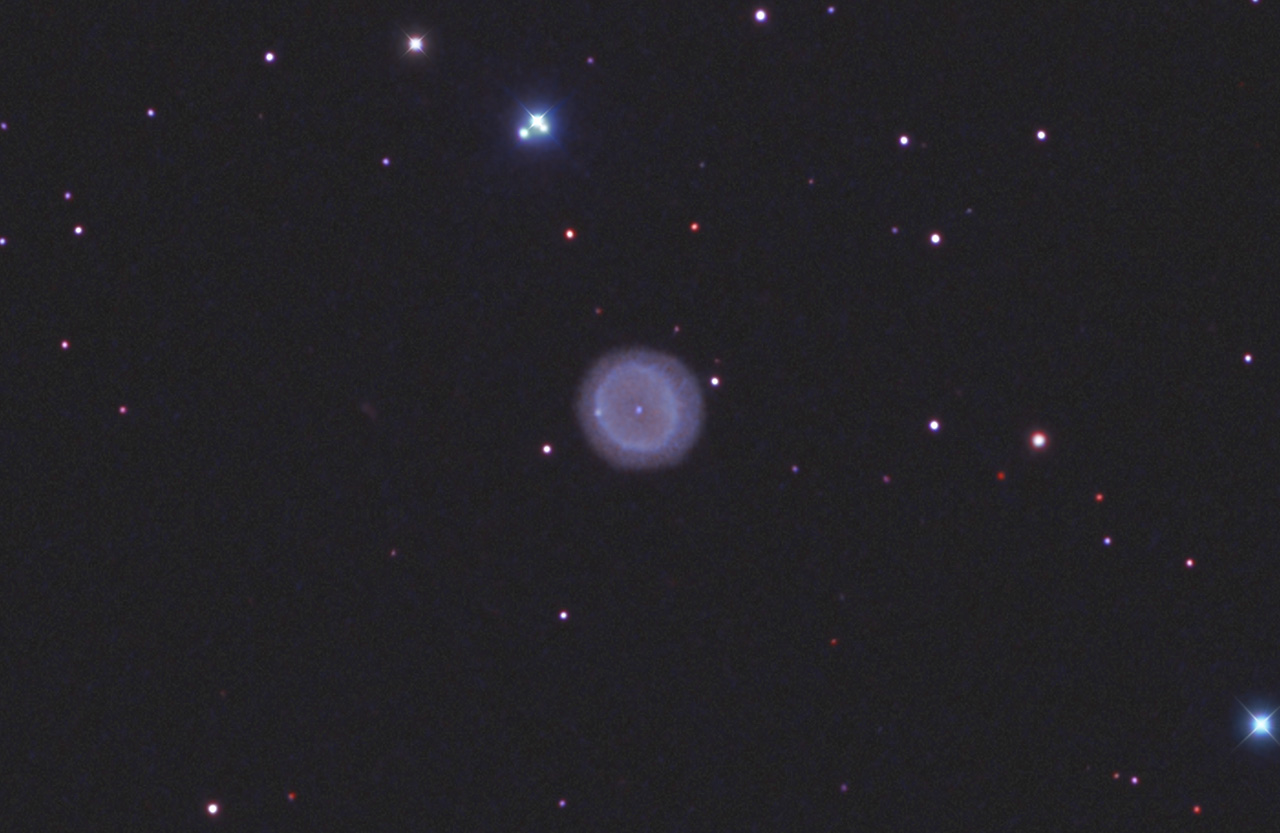 |
Baade 1
|
|
19th February 2017Close encounter of the Planetary Nebulae kind - HFG1 & Abell 6 |
When I shot Abell 6 in 2013 I also shot a widefield view which picked up HFG1 as well. In fact it was how I first became aware of HFG1. So once I had returned for an image of HFG1 it was natural to put everything together in one image. It has ended up very much as "little and large". Their separation is a fraction under 40 arc-minutes. Due to the rapid motion of HFG1 this chance encounter won't last long - well on galactic timesales that is! Image Details
|
|
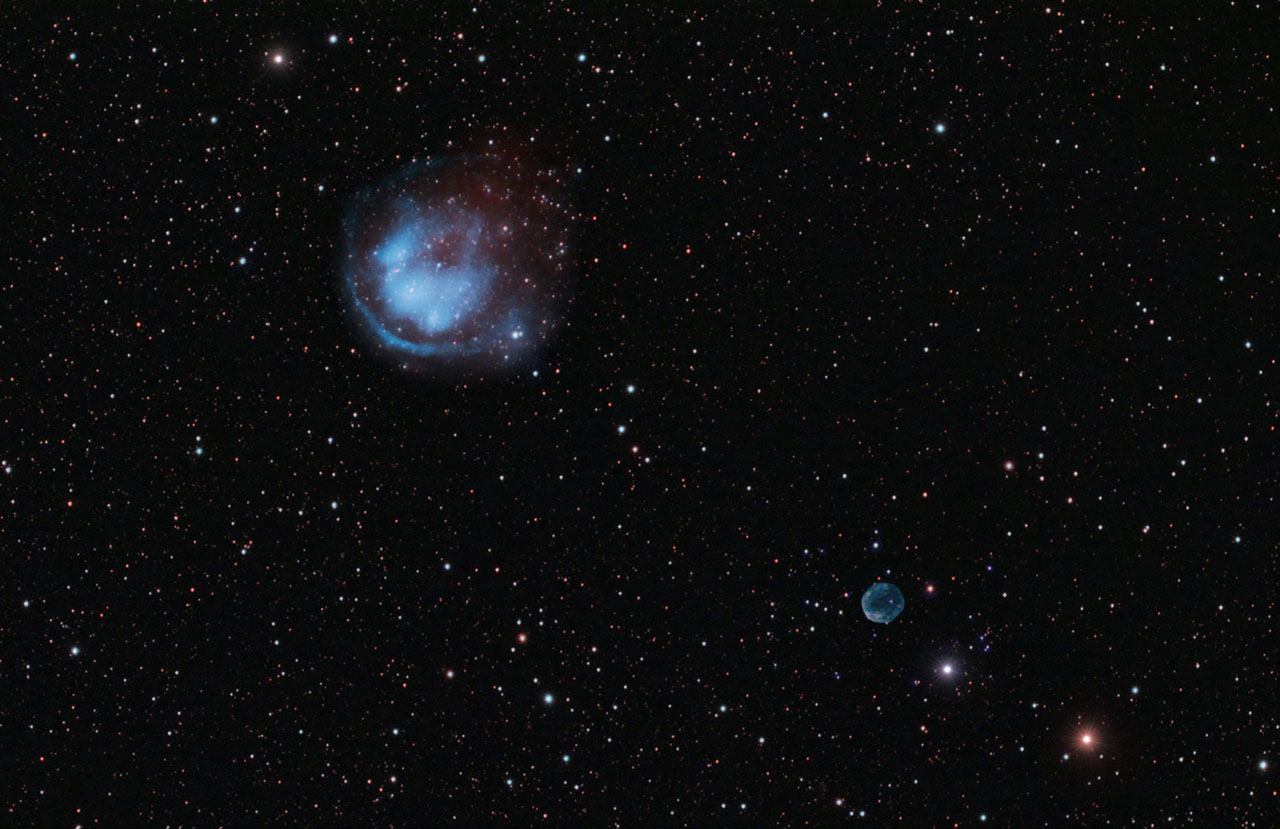 |
HFG1 and Abell 6
|
|
12th February 2017Planetary Nebula HFG1 |
As planetary nebulae go this one is huge. So you would think its name must stand for Huge Friendly Giant 1. But no - it' is named after its discoverers Heckathorn, Fesen & Gull, who first spotted it in 1982. Its central star is V664 Cas, which is a 14th mag variable. It comprises a very close pre-cataclysmic binary system with a period of around 14 hours and the main emission comes from a “hot” spot on the primary. Originally it was a 3 Solar mass star but has lost 2.4 solar masses to the nebula leaving its current mass as just 0.6 solar masses. It is moving fast towards the south-east (bottom left) leaving a trail behind it and creating a shock front on its leading edge. This is the longest exposure I have managed at 20 hours total which gives a clue that this object is faint. The central portion can be recorded pretty easily but the OIII ring/shock front is just about at my limit. Really to do it justice a dark sky and ultra-narrow band filters are needed. Image Details
|
Type of object: Planetary nebula RA (J2000.0): 03h 03m 48.8s Dec (J2000.0): +64° 53' 28" Constellation: Cassiopeia Magnitude: 16.0 Size: 8.3' (OIII ring approx 15' dia) Magnitude of central star: 14 variable
|
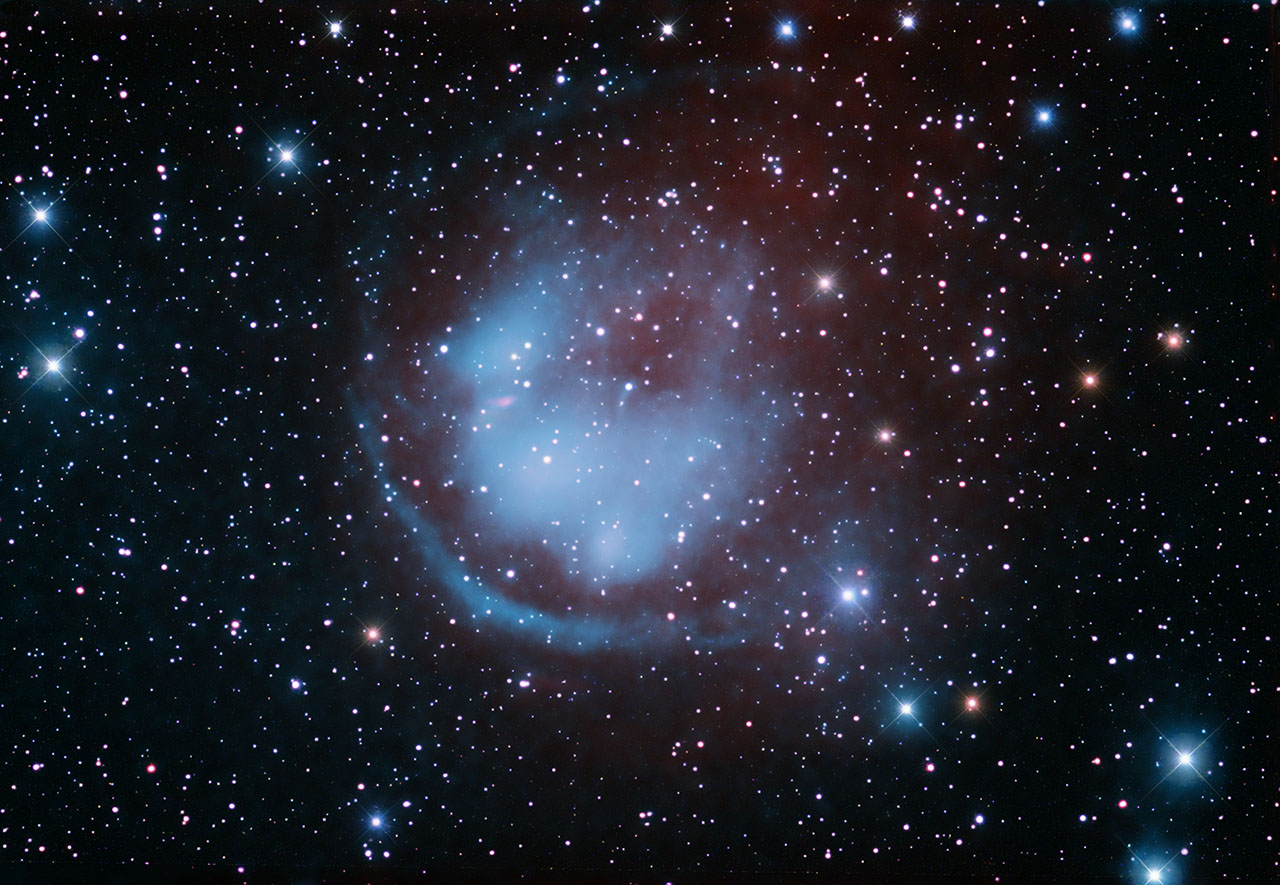 |
HFG1
|
|
29th January 2017Planetary Nebula Abell 5 |
This Planetary Nebula does exist but there is virtually no data or images of it! I was asked if I had an image of Abell 5 by Owen Brazell, writer of Deep-sky Challenge section for Astronomy Now magazine. The answer was not yet but it was on my list for this winter. He was considering it for one of his forthcoming challenges for visual observers. However, following my my reports that is was mighty faint on my OIII exposures, he decided against setting this object as a challenge even for the big Dobsonian boys. The OIII band is the filter of choice for visual PN observers as our eyes are pretty insensitive to h-alpha. The H-alpha does record reasonably well if not brightly but the OIII is extremely faint. I really needed 30 minute sub-exposures. The central star is brightest in the UV and is only mag. 21.4 in the visible so was out of reach for me using narrowband filters. Image Details
|
Type of object: Planetary nebula RA (J2000.0): 02h 52m 18.0s Dec (J2000.0): +50° 36' 00" Constellation: Perseus Magnitude: 16.0 Size: 2.2'x2.0' Magnitude of central star: 21.4 (V) Object classification: 4 |
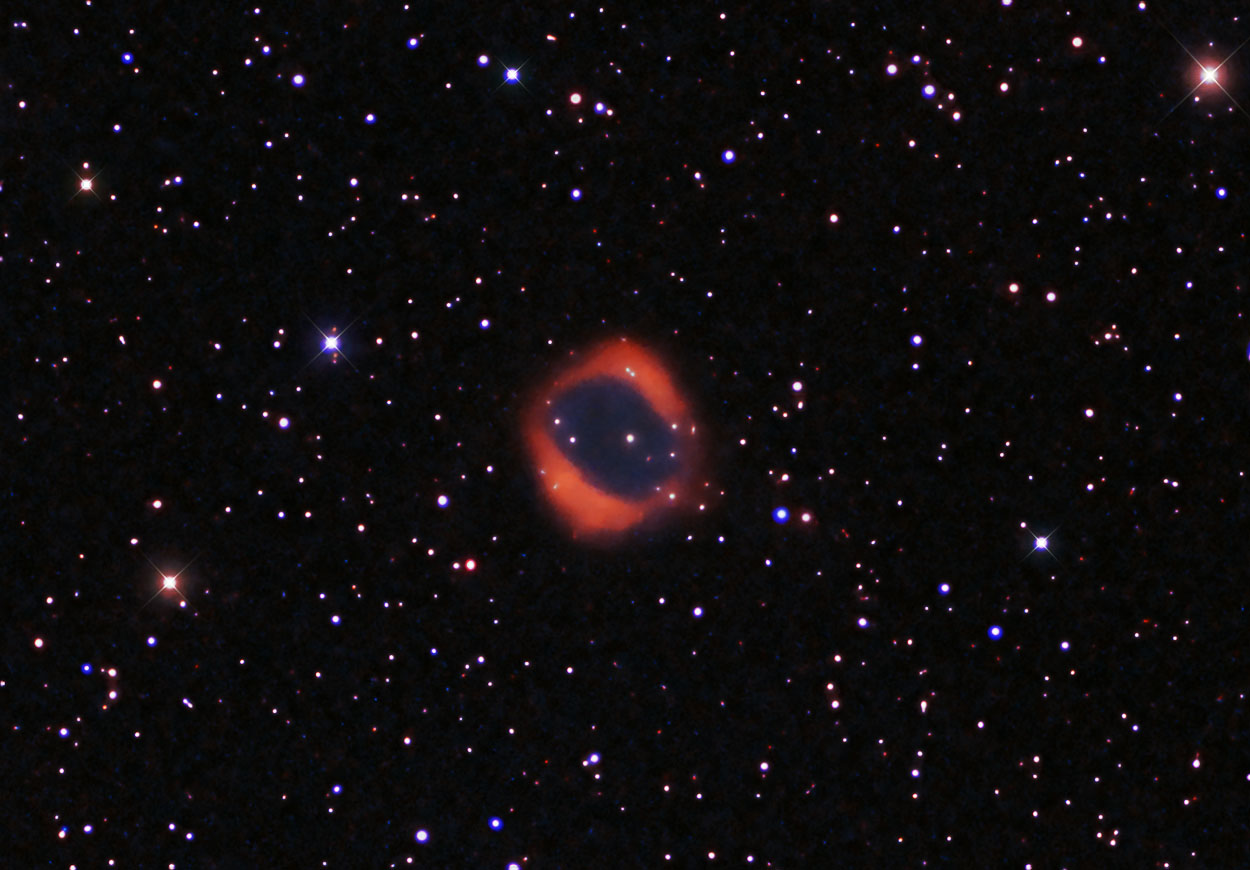 |
Abell 5
|
|
15th January 2017Pisces Cloud Galaxy Cluster (Zwicky 0107.5+3212) |
The Pisces Cloud actually refers to the whole cluster whereas the north-south chain of mainly elliptical galaxies is more accurately known as Arp331. The cluster is in turn part of the huge Perseus-Pisces supercluster. Current distance estimates for the Cloud place it just over 200 million light years away. The cloud (and chain) is centred on NGC 383. There is some debate as to whether this an elliptical galaxy or an S0 type. It is also known as 3C 31 - a Fanaroff-Riley type I radio galaxy. Compared to quasars, these are (relatively) low-powered radio-galaxies with active galactic nuclei and relativistic jets (see right). As the jets move out from the nucleus they interact with the interstellar medium producing shock fronts and eventually slowing down. The jets are fueled by material accreting onto a super-massive black hole. The high energy particles are shot into extragalactic space at speeds approaching the speed of light, where they eventually spread out into massive radio plumes extended further out than the complete chain. Image Details
|
|
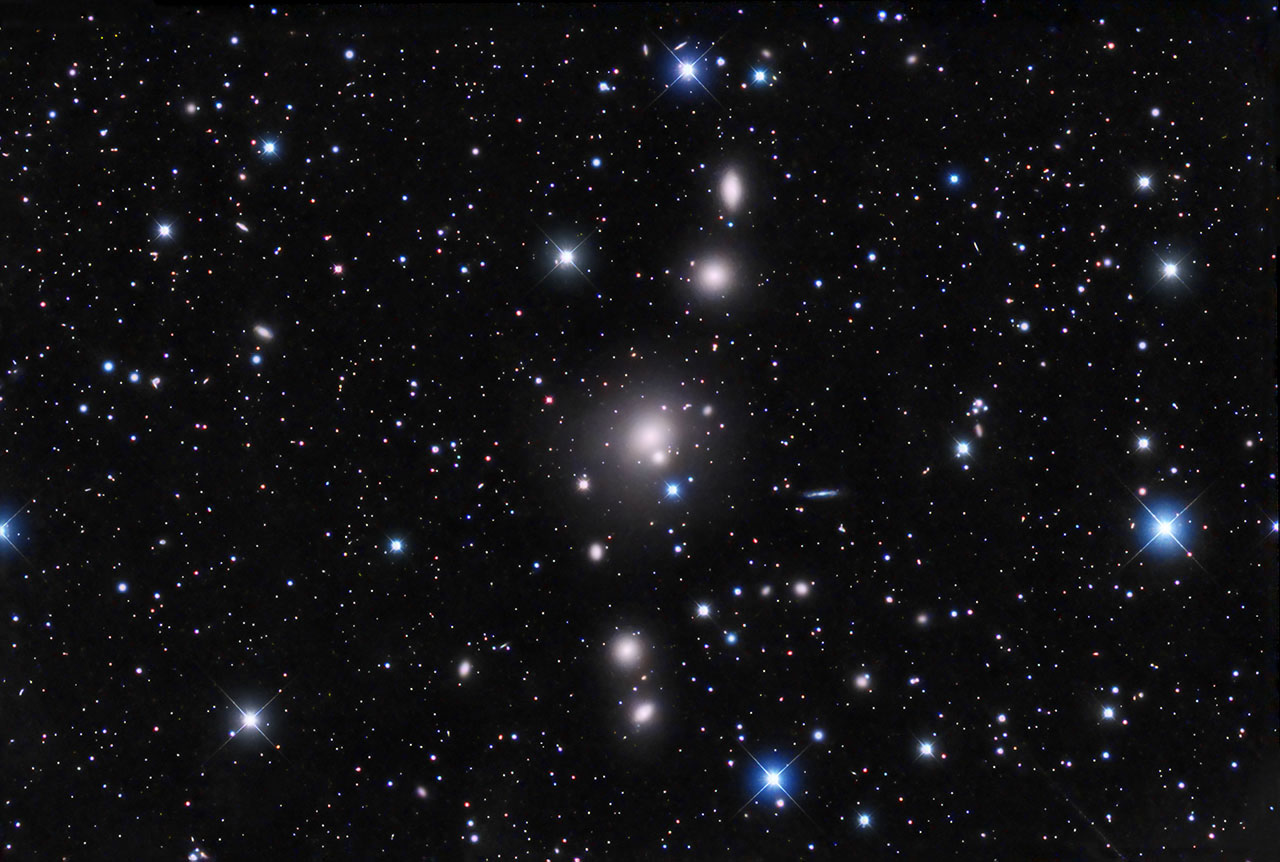 |
Pisces Cloud
|
|
1st January 2017Galaxy NGC 1023 (Arp 135) |
NGC 1023 is the brightest member of the LGG 70 group (Garcia 1993) and is overlaid by its closest companion NGC 1023A. The latter is a low-luminosity patch located near the eastern (left) end of the galaxy. NGC 1023A was first recognised as an individual galaxy by Barbon & Capaccioli (1975) and classified as Magellanic irregular or late-type dwarf galaxy by Capaccioli et al.(1986). It is slightly bluer than NGC1023. NGC 1023 is classified as a barred lenticular SB0 galaxy and is located in Perseus. Forbes et al (2014) used Hubble Space Telescope images to study "faint fuzzies" (FF) ie clusters in NGC 1023 (right). Their image also recorded 2 Ultra Compact Dwarfs (UCD) marked with magenta squares. These rare objects were originally thought to be found only in large clusters but have now been found elsewhere as is the case here. Latest thinking is they are more likely not ultra compact dwarf (galaxies) but super star clusters, 10 times the size of globular clusters. However, the jury is still out on this one. Note the Hubble image for some reason has misplaced stars. Aligning it with my image was tricky until I realised what was wrong. How they have ended up with stars in the wrong place is a puzzle.
Image Details
|
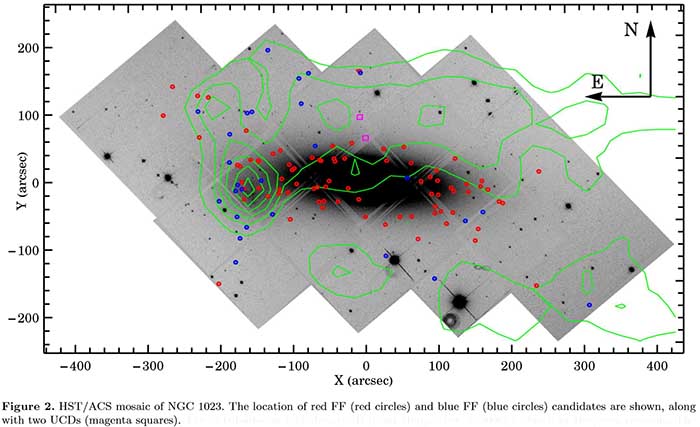
(Location of red and Blue FFs plus the 2 UCDs in a Hubble image of NGC 1023 - Forbes et al. 2014. Forbes et al. didn't make a good job of their mosaic image and several stars are misplaced! |
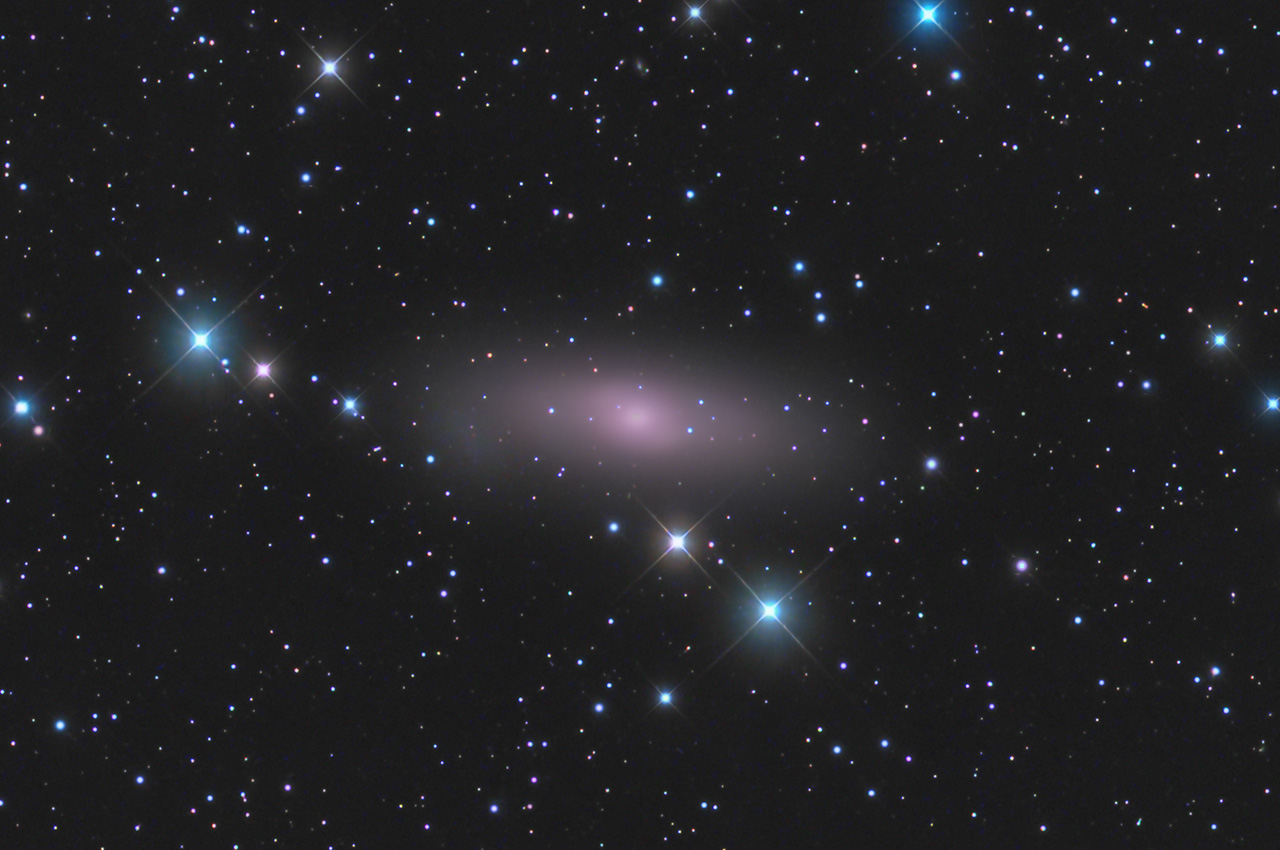 |
NGC 1023
|
|
To continue with the imageBLOG for 2016 Click Here
Recommended full colour book covering all aspects of digital imaging: "Digital Astrophotography - The State of the Art" edited by David Ratledge Order Online |
Please remember these images are copyright David Ratledge. Contact me before any use is made of them.
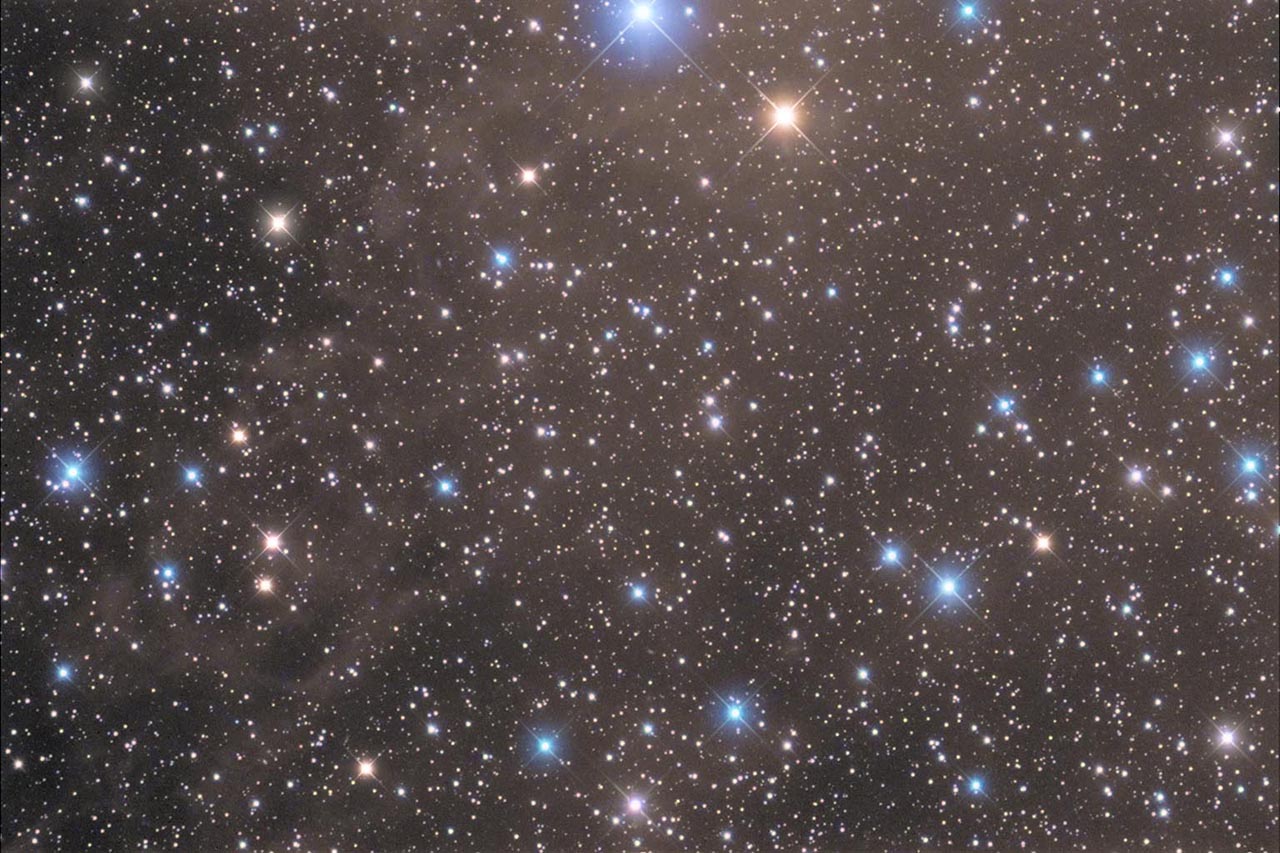
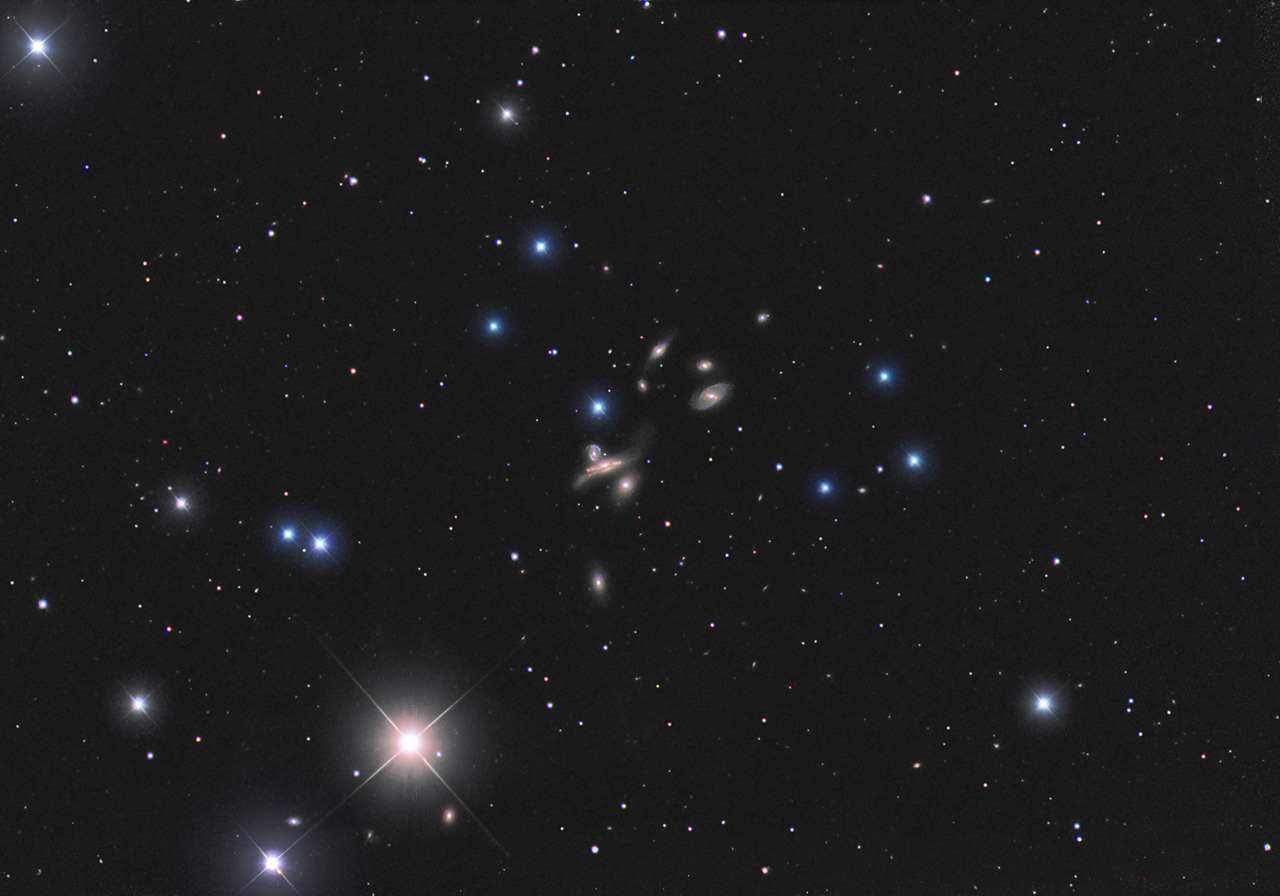
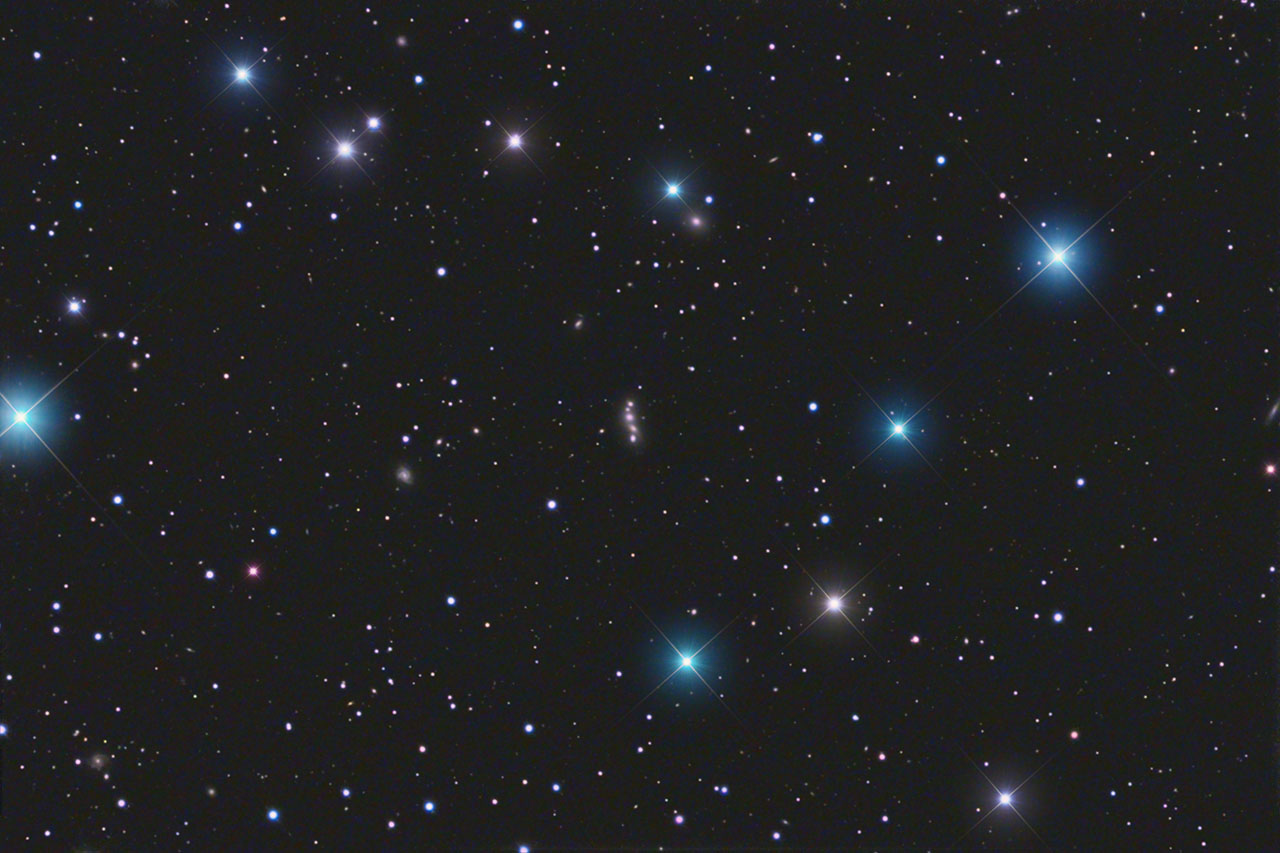
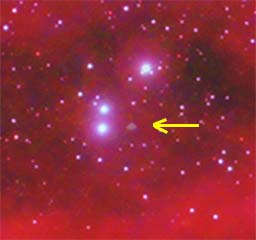
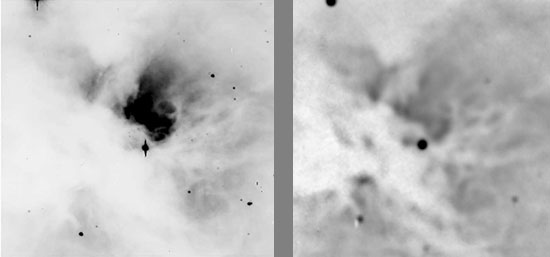
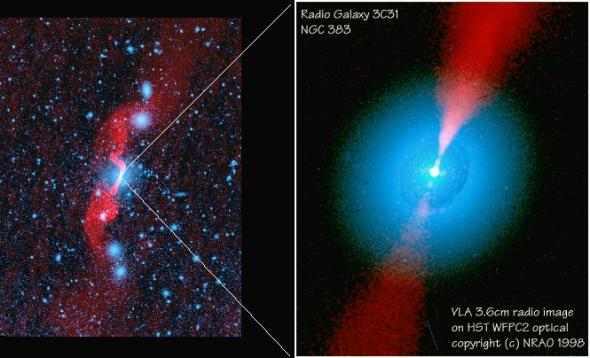
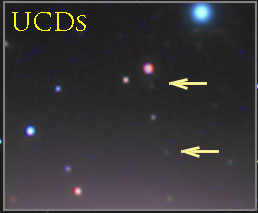 Blow-up of the UCDs from my image below.
Blow-up of the UCDs from my image below.